Greenhouse technology outpaces Ontario’s infrastructure capacity
KAREN DAVIDSON
Planet Earth makes one revolution around the sun every year.
This year, Peter Quiring is marking 30 such revolutions of his own. First, as a greenhouse builder founding South Essex Fabricating. Then, as a startup greenhouse grower building Nature Fresh Farms into an internationally respected brand. And today, he’s on a personal mission to expand the foods that can be successfully grown under glass.
“I have no idea of where things are going with this persistent inflation and the results of both good and bad decisions by government,” says Quiring at his Leamington, Ontario headquarters. “I see the future as unstable until this reckless printing of money translating to high interest rates on both sides of the border stops and inflation cools down.”
Uncertainty aside, Quiring is preparing for the future with an R & D Centre that’s literally growing everything under the sun: papaya, figs, melons, limes, bananas, peaches and leafy greens. The category that’s most ripe for expansion right now though, is berries, specifically raspberries and blackberries. Statistics Canada, now tracking greenhouse berry production, reported 2021 sales of $18.5 million with Ontario being the largest producer of greenhouse strawberries at 2.2 million kilograms.
With 2021 strawberry imports to Canada valued at $643 million and an often temperamental climate in the U.S., Quiring sees opportunity to fill the seasonal void of field-grown berries with Nature Fresh-grown product. And he looks to enhance Canadian food security in the bargain.

“We’re really just starting to research what to grow and how to grow,” says Quiring, pointing to blackberries fruiting on trellises. “Varieties are proprietary because everything we do is about taste. We still need to answer
the question of whether the quality is better and whether there’s a compelling reason for a retailer to buy our product.”

Agronomic hurdles are the same as with greenhousegrown tomatoes, peppers and cucumbers -- categories that Nature Fresh Farms have mastered on both sides of the border. R & D head grower Matt Korpan is quick to point out that there are more questions than answers about what climate, lighting and varieties work best. His team of 20 includes specialists in several disciplines: propagation, horticultural crop research, IPM, post-harvest research, consumer tasting, data science, genetics, sensor technology and robotics.
Nature Fresh Farms work collaboratively with seed companies in Holland and California as well as with global leaders in horticultural lighting.
Continued on page 3
SEPTEMBER 2023 CELEBRATING 144 YEARS AS CANADA’S PREMIER HORTICULTURAL PUBLICATION THEGROWER.ORG THE WILL TO GROW
Volume 73 Number 09 P.M. 40012319 $3.00 CDN @growernews Recognized Employer Pilot PG 2 Plastic packaging reductions PG 10 Greenhouse innovation PG 12
Greenhouse pioneers are pushing the boundaries as to what can be grown in a controlled environment. Having mastered tomatoes, cucumbers and peppers in both Canadian and American locations under the brand of Nature Fresh Farms, Peter Quiring and his R & D team see promise in the berry category. Here, blackberries are trellised in a Leamington, Ontario greenhouse. Photos by Marcella DiLonardo.
Industry applauds Recognized Employer Pilot
Canada’s “jobs minister”
Randy Boissonnault is receiving praise for major changes to the recruitment of temporary foreign workers. As of September 2023, farm employers in good standing will be able to apply for their 2024 labour force using a streamlined process. The paperwork will cover a period up to 36 months rather than 18 months under the previous system.
“Fruit and vegetable growers have long been asking for a streamlined application process for employers with a strong history of program compliance, which makes this announcement a particularly welcome step forward,” says Bill George, a grape grower and chair of the labour section, Ontario Fruit & Vegetable Growers’ Association. He says that about 20,000 seasonal and temporary foreign workers come to Ontario legally through the governmentregulated SAWP and TFW ag stream program. In Québec, the numbers are about the same.
In tackling labour shortages, the federal program is also mindful of protecting foreign workers. In his August 8 news conference, Minister Boissonnault stated clearly -- in both English and French -- that migrant workers have the same workplace protections and rights as other Canadians and permanent residents doing the same work.
He shared that between April 2022 and March 2023, the federal government conducted 2,100 inspections of employers enrolled in the Temporary Foreign Worker program. Of those employers inspected, 117 were found to be out of compliance, 94 were fined a total of $1.5 million and six were barred from the program for five years.
Once here, these legal workers have the same rights and privileges as Canadian workers doing the same work and their farm employers, who are subject to frequent federal, provincial, and foreign government compliance inspections, have the same, and in some cases higher obligations to them as they do for their Canadian employees. This includes government-approved wage rates, access to health care under OHIP, Employment Insurance and the Canada
"It's paramount that we prioritize the protection and well-being of international farm workers who play a critical role in our industry,” added Beth Connery, national labour chair, Fruit and Vegetable Growers of Canada.

“The Canadian fruit and vegetable sector is committed to diligently complying with labour standards and appreciates the steps the Government has taken to ensure that international workers are protected.”
To participate in the Recognized Employer Pilot (REP), employers must have a minimum of three positive Labour Market Impact
Assessment (LMIAs) for the same occupation over the past five years from a list of occupations that have been designated as in short supply.
Employers who become recognized will gain access to LMIA validity periods of up to 36 months, and, if required, simplified LMIA applications to hire additional workers in the future.
According to a government backgrounder, employers who are expected to meet REP eligibility criteria will be proactively invited to apply using a dual-purpose LMIA application which differs from the regular LMIA. Employers can request that the application be used to apply for recognized status under REP and for the LMIA at the same time. Employment and Social Development Canada (ESDC) will determine REP eligibility based on the employer’s history with the TFW Program. Should an employer not receive recognized status, they will remain eligible to use the TFW Program and the Department would continue to assess their LMIA.
There are two ways to apply:
1. Through the LMIA Online Portal, a reliable and secure platform where employers can complete and submit an online application to ESDC; or,
2. If the employer has a valid proof of valid exemption to the LMIA Online Portal, they can email a PDF application form to ESDC.
Prince Edward Island MP Lawrence MacAuley is back in the role of federal minister of agriculture and agri-food after the prime minister shuffled his cabinet on July 26. Québec MP MarieClaude Bibeau moves to the ministry of national revenue after serving four years in the ag portfolio. MacAuley, 77, was previously agriculture minister from November 2015 to March 2019.

Congratulations to Andrew Moon, winner of the BC viticulturist award for 2023, presented by the BC Grapegrowers’ Association. He’s the viticulturist from Tinhorn Creek Winery in Oliver, British Columbia. He has 30 years of growing experience, starting in Australia and moving to Canada in 2009. He experienced the coldest year on record in BC in 2009, the hottest in 2015 and again in 2023, one of the most harshly damaged grape crops in years.

The University of Guelph has named Dr. Rene Van Acker, professor and dean of the Ontario Agricultural College (OAC), as its interim vice-president (research). He will take on the interim position immediately as a secondment from his role as OAC dean. He replaces Dr. Malcolm Campbell as vicepresident (research), who stepped down on July 20.

Syngenta Canada Inc. has named Shaun Vey as head of sales, crop protection effective August 1, 2023. He will lead the national sales and key account team from the company’s office in Calgary, Alberta, and serve on the organization’s leadership team. Most recently, he gained international experience as head of marketing for Syngenta UK, Ireland & Nordics.
Sarah Nicols, Canlead, is the new administrator for Fresh Vegetable Growers of Ontario. The organization, chaired by Norm Charbonneau, is encouraging new members to sign up. No fees are required. Send requests for membership to Lona Ponte at info@freshvegetablesontario.com or call 1-800-769-3272 ext 205.


The 2023 board of directors includes: Mark Srokosz – Region 1
Mark Wales – Region 2
Quinton Woods – Region 3
Joann Chechalk – Region 4
Henk Droogendyk – Region 5
Norman Charbonneau (Chair) – Cruicifer Crops
John Gorzo – Low acreage & Specialty Crops
Teresa Van Raay – Root bulb & Leafy Vegetables
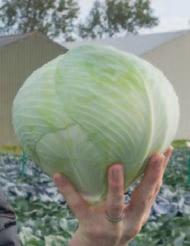

John Hodkinson – Tomato & Peppers

Morris Gervais – Sweet Corn, Peas & Beans
Vermillion Growers opened a new greenhouse at Dauphin, Manitoba on July 27 says Maria Deschauer, co-founder and managing director. The new 10.8 acre greenhouse is dedicated to tomatoes on the vine. It’s the first commercial greenhouse in Manitoba. More phases are planned.
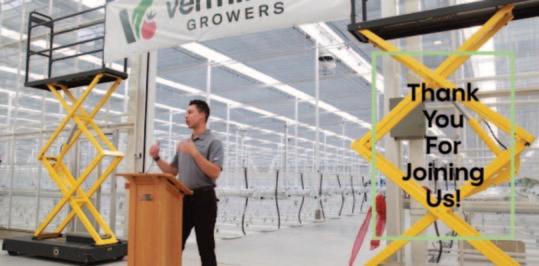
THE GROWER AT PRESS TIME… PAGE 2 –– SEPTEMBER 2023
NEWSMAKERS
Proud of our roots since 1928 norseco.com AXEL Storage cabbage, 昀rm and uniform with an upright plant habit. Strong against Fusarium and Black Rot. Easy to harvest and keeps clean. EXPECTATION For long-term storage. Holds its freshness appearance. Tolerant to thrips. Maturity: 92 days Customer Service order@norseco.com 514 332-2275 | TFN 800 561-9693 450 682-4959 | TFN 800 567-4594 North Shore of Montreal Isabelle Dubé, Agr. isabelle.dube@norseco.com 514 295-7202 Central & Eastern Québec Yves Thibault, Agr. yves.thibault@norseco.com 418 660-1498 Eastern Montérégie & Maritime Provinces Marie-Pierre Grimard, P. Tech marie-pierre.grimard@norseco.com 450 261-7468 Western Montérégie Marie-Hélène Monchamp marie-helene.monchamp@norseco.com 514 968-2906 Ontario Warren Peacock warren.peacock@norseco.com 519 427-7239 MB, SK, AB & BC Ben Yurkiw ben.yurkiw@norseco.com 604 830-9295 Sales Representatives norseco_of昀ciel
Lawrence MacAuley
Photo courtesy of Myrna Stark Leader
Dr. Rene Van Acker
Greenhouse technology outpaces Ontario’s infrastructure capacity

Continued from page 1
“We have yet to nail down the lighting recipes for each of these new crops under greenhouse conditions,” says Korpan. “Our climate in southwestern Ontario – humidity and light intensity – is much more extreme than in the Netherlands. We have figured out how to control the environment in winter. But in the summer with warm nights and high humidity, it’s about how we take away that heat and humidity.”
To date, there’s little research on blackberries and raspberries in lit greenhouses outside of Holland, Belgium and some Nordic countries. Brambles, members of the genus Rubus, are known for their prickly and rambling bushes that reach across rows in the field. To be economical for harvesting under greenhouse conditions, the plants are coaxed to grow heavenwards on a trellis almost two meters in height. As Korpan elaborates, the goal is to grow blackberries and raspberries in the off season and meet needs outside the highquality, locally grown, field berry summer market.
“We’re learning about flavour at different crop stages,” says Korpan. “Some varieties are very sweet like a raspberry then the next variety will taste more like a grape or a plum.”

Varieties are proprietary because everything we do is about taste. We still need to answer the question of whether the quality is better and whether there’s a compelling reason for a retailer to buy our product.
~ PETER QUIRING
But research on taste is done alongside yield considerations. Under greenhouse conditions, more than one crop cycle is expected, allowing for potentially higher berry yields that might help to offset higher growing costs. And consider this. Brambles need a chilling period. Waking up the plants must be timed so that they are producing berries during the most economically rewarding sales window.
Korpan believes that commercialization of greenhousegrown blackberries and raspberries may be as little as five years away and getting positive results sooner rather than later is what inspires his team.
Amplifying this approach, Quiring observes, “How research dollars are spent in the western world and particularly in North America should change. Most of the money goes to programs which don’t incentivize commercialization. We would prefer a closer collaboration and communication with the grower community. That’s why we have our own R & D Centre.”
Considering such research is likely to be implemented in Canada, Quiring goes on to highlight a critical obstacle: “There are 640 acres in a square mile. And we have 3,800 acres of greenhouse production in all of Ontario. Space is not the
Source: OGVG Growth & Sustainable Prosperity Study 2023
problem. Infrastructure is.”
This point is amply reinforced by the “Growth and Economic Prosperity Study” just published by the Ontario Greenhouse Vegetable Growers (OGVG). Employing an Enterprise Risk Management Framework, the first of its kind by an agricultural sector in Ontario, the study highlights a myriad of risks and warnings.
“Whether it’s water, hydro, natural gas, housing or roads, all of these essential services are in short supply for a greenhouse sector that’s forecast to grow by five per cent annually over the next decade,” says Richard Lee, executive director, OGVG. “For growth to take place, we need the right partnerships with all levels of government.”
Ontario’s greenhouse vegetable sector represents $2.3 billion in gross domestic product contribution, accounts for 81.6

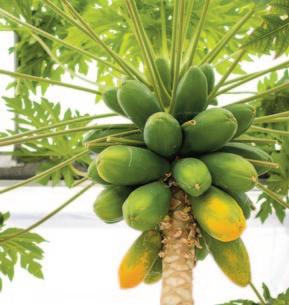
per cent of total Canadian greenhouse vegetable exports and employs more than 32,000 people practising a broad range of skills. Boasting farmgate value of $1.3 billion, Ontario is home to world-class greenhouse expertise with the will to grow. Up to now, a seemingly patchwork approach has resulted in mis-aligned municipal, provincial and federal infrastructure policies and regulations. The gap is widening between industry needs and local services capacity.

Ontario, a place to grow? Is that today? Because for the greenhouse industry, tomorrow is already here.
For sidebar, go to page 4.
The Grower is “Digging Deeper” with Peter Quiring, owner of South Essex Fabricating and Nature Fresh Farms. The pioneer has set up an R & D Centre near Leamington, Ontario to see what crops can be grown in a controlled environment. After mastering strawberries, he sees the next big opportunity in blackberries and raspberries. This podcast is sponsored by Cohort Wholesale.

SEPTEMBER 2023–– PAGE 3 THE GROWER COVER STORY
This cornucopia of fruits and vegetables represents a two-day harvest of everything grown in a R & D greenhouse at Leamington, Ontario. Peter Quiring, (L) owner of South Essex Fabricating and Nature Fresh Farms is pictured with head grower Matt Korpan and assistant grower Punit Singh. The grower team harvested the first winter-grown peaches in Canada in January 2023.
“
Table 1: 2022 Regional Impacts of greenhouse vegetable agriculture in Ontario
Figs Papaya
Bananas
R & D leads to spin-off service
Jorik Visser can be found inside a non-descript lab, sleuthing the greenhouse industry’s biggest biological challenges: tomato brown rugose fruit virus (ToBRFV), cucumber green mottle mosaic virus and Fusarium on peppers. He’s the R & D geneticist for South Essex Fabricating, a key cog of Peter Quiring’s vision for providing solutions to threats to the $1.3 billion sector centred in Leamington, Ontario.
The laboratory is situated in Quiring’s R & D centre that’s investigating if it’s possible to grow crops as diverse as papaya and peaches under a greenhouse roof. Set up in November 2020, the laboratory has proved indispensable to the research team for its ability to sequence DNA of tender seedlings for agronomic traits. There’s no need to continue with a thousand seedlings if only a handful have the genetic potential to perform well in a greenhouse setting.
As Visser explains, “Within a week of germination, we can tell which plants to eliminate and focus on what’s going to thrive.”
As the laboratory was being set up three years ago, Visser quickly realized that the greenhouse community at large was dealing with ToBRFV, a virus so aggressive that the standard sanitation methods were not containing the spread. Drainage water was carrying the virus. Contaminated dust from clean-outs spread to neighbouring facilities. Growers were having to pull out crops that could not run the full production cycle of 50 weeks. In some cases, the tomato crop was infected at 12 weeks, and growers had to replant.
“PCR tests showed that ToBRFV could be found everywhere, from the shoes of workers to work surfaces and cars,” says
CROSS COUNTRY DIGEST
BRITISH
COLUMBIA
Visser. “The industry was bleeding in early 2021.”
Under Visser’s guidance, the laboratory started testing various disinfectants as well as the sanitation equipment. Working with equipment manufacturers, Visser determined what precise adjustments were needed for a more satisfactory control procedure. Today, ToBRFV is an ongoing danger, but is more widely understood and better managed by greenhouse tomato growers.
On the other hand, greenhouse pepper growers are now battling Fusariam solani and F. oxysporum. The fungus can invade pepper stems at the nodes, taking advantage of wounds created by pruning. The result is wilting plants and spoiled fruit. Collectively, Ontario growers pulled out more than 200 acres of peppers in 2022 due to Fusarium infections.
Thanks to high through-put, thirdgeneration DNA sequencing equipment sourced from Oxford Nanopore Technologies in the UK, the R & D laboratory is capable of analysing a leaf, soil or water sample in a single day. These results can help growers diagnose their problem in real time rather than wait for other laboratories that can’t turn around results in less than 20-30 days. These rapid answers are critical for high-value crops.
“We’re not entirely sure why Fusarium is such a problem now, but we’re speculating that hotter summers are changing the way that the fungus can infect the plant,” says Visser. “Certain environmental factors – humidity and high temperatures – may be triggering the fungus to become more pathogenic. We don’t know what the exact mechanism is yet.”
Until recently, these diagnostic
laboratory services have been available only to Nature Fresh Farms’ clients. But Visser says that samples are now welcome from the broader greenhouse community. The genetics lab’s PCR tests start at $85 per sample.

The grower can expect whether there is the presence of a single viral pathogen and the amount of virus present in the sample.
DNA sequencing is more expensive at $400 per single sample for a result that can identify all fungi, bacteria and DNA
New website launched on orderly marketing of BC apples
A new website has been launched to inform and engage British Columbia’s commercial apple growers about the potential of “Orderly Marketing” for the province’s apples. In recent years many apple growers report they have faced significant financial stress as evidenced by continued poor grower returns, shrinking acreage, and reduced market share even in British Columbia.
Growers and other apple industry partners have begun to consider several ideas to help return financial stability to one of BC’s oldest and most iconic industries. One possible solution is orderly marketing.

A new website, https://appleorderlymarketingforum. wordpress.com/ has been developed by the Orderly Marketing Project Management Committee, a volunteer committee of growers and industry representatives, to explore the idea of orderly marketing for BC apples.
“Orderly marketing is simply a way to describe how BC apple growers may achieve better results – for example, in marketing and promotion - by working together rather than apart,” said Glen Lucas, general manager of BC Fruit Growers’ Association. “Several other commodities have benefitted from some form of orderly
MANITOBA
viruses present. It’s likely that demand for these services will spike so more equipment is on order to automate extraction and sample preparation.
South African-born geneticist Jorik Visser has declared molecular biology and plant genetics as his passion. He’s one of many international specialists that Peter Quiring has attracted to Leamington to make the greenhouse community more competitive.
marketing, each designed to serve the unique needs of that sector.”
“The purpose of this new website is simply to begin sharing information about what orderly marketing is. And what it isn’t. Growers will begin to receive more information over the next few months, and we encourage them to become informed and participate in the discussion.”
In 2021, the BC Ministry of Agriculture, Fisheries and Food, issued The Path Forward: A Blueprint for B.C.’s Tree Fruit Industry which contained a set of recommendations designed to assist the industry. Since then, the Tree Fruit Industry Stabilization Advisory Group began looking at a range of issues, including marketing.
With assistance from the BC Investment Agriculture Foundation, some of the world’s leading agricultural economists have been retained to examine the marketing of BC apples and the potential of a more united approach in areas such as industry-wide promotion and quality standards. The results of this work will be made available to growers as it is completed.
“We are asking growers to get involved: check out the
Manitoba is headed into an election on October 3
Manitoba Premier Heather Stefanson has committed to the scheduled provincial election date of October 3. For the Keystone Agricultural Producers, the advisory council indicated that election issues revolve around five key priorities: healthcare and rural crime; education and
property taxes; labour shortages, infrastructure spending and right-to-repair legislation.
Peak of the Market Ltd. indicated the importance of investing in agricultural innovation and sustainable practices as well as continued collaboration with growers
website, meet with other growers to discuss this idea and ask lots of questions,” said Lucas.
Over the next few months, more information will be added to the website based on feedback from growers.
Source: BC Orderly Marketing Project Management Committee, August 10, 2023 news release
and key stakeholders in the industry.
The incumbent Progressive Conservative Party of Manitoba will attempt to win a third term in government, having won the 2016 and 2019 elections.
PAGE 4 –– SEPTEMBER 2023 THE GROWER
COVER STORY
Supporting the agronomic efforts is a separate quality assurance lab helmed by R & D geneticist Jorik Visser. Efficient, timely turn-around of plant tissue results are critical to a sector that must be vigilant against viruses and invasive pests.
CROSS COUNTRY DIGEST
Québec growers seek relief after deluges of rain
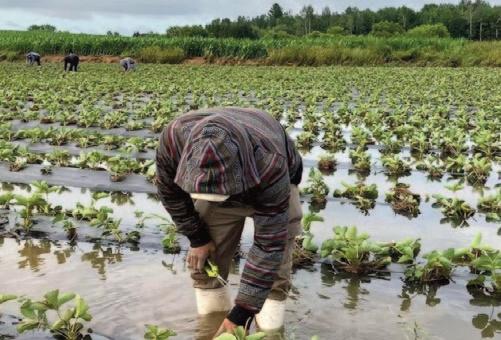
On August 4, Québec growers staged a news conference in Ste-Clotilde-de-Châteauguay to underscore the rain-related damages that have accumulated all summer to berry and vegetable crops. The growers, accompanied by leaders of the Union des producteurs agrioles (UPA), are seeking provincial relief.
Berry growers are worrying about risks of climate change for the 2024 and 2025 harvests, says Michel Sauriol, president of the association of strawberry and raspberry producers. Growers can control drought with irrigation, but they can’t mitigate the damage of hundreds of millimeters of water falling within an hour.
For one, Julien Cousineau received hail one inch in diameter for 15 minutes, shredding 100 acres of broccoli and onions, the night before the news conference. Others in the Montérégie region say that so much rain has been received that the fields are unwalkable and that equipment
can’t enter to do crop protection treatments.
“Unfortunately, it’s a perfect recipe for wiping out this year’s work, but for some it’s the work of a lifetime,” said Catherine Lefebvre, president of the Association des producteurs maraîchers.
The farmers are seeking provincial relief, separate and distinct from federal programs. Specifically, they are asking for deferment of payment of premiums to the crop insurance program and a holiday on payments on loans to the Financière Agricole. If they can gain the Québec government’s acknowledgement of the state of weatherrelated disaster, then there’s a better case to be made to financial institutions for individual relief.
The growers made the point that they can’t go into debt to feed Quebecers. Provincial ag minister André Lamontagne has acknowledged that the unusual weather has affected several regions and a variety of products.
CFIA completes soil testing for potato wart in PEI
The Canadian Potato Council (CPC) is pleased that the Canadian Food Inspection Agency (CFIA) has completed its investigation in Prince Edward Island. Since fall 2021, almost 50,000 soil samples have been collected on the Island as part of CFIA’s investigation to manage potato wart.
“I would like to thank CFIA for its
NOVA SCOTIA
ongoing efforts to efficiently collect and process the high volume of soil samples over the past 20 months,” said CPC’s chair Bill Zylmans. The thorough investigation unearthed only four finds of potato wart spores in fields that are associated with the same operation and in land that is part of the Potato Wart Long-Term Management Plan. That is 0.008% incidence.
Source:
Investigation results indicate limited incidence in fields growing potatoes destined for the on-island processing market. The recent detections are within a distance of 12 km of each other and continue to be monitored and regulated under CFIA’s Potato Wart Long-Term Management Plan.
“We look forward to working with the
federal government to review the longterm management plan this fall as part of our commitment to guide our decisions based on data, science, international standards and best practices,” added Zylmans.
Source: Canadian Potato Council August 18, 2023 news release
New technology, knowledge and equipment showcased in apple orchards
EMILY LUTZ
The International Fruit Tree Association (IFTA) held its mid-summer tour in the Annapolis Valley of Nova Scotia on July 23-25th, 2023. Almost 150 growers and industry members from around the world gathered to take in the success of the Nova Scotia industry and see how things have been growing.

The event started with a meet-and-greet evening at the Old Orchard Inn where local craft beverages were showcased from the ever-expanding wine, beer, and cider industry in Nova Scotia. Day one of the tour was Monday July 24th started at Birchleigh Farms operated by Waldo, Judy, and Alex Walsh. Researcher Keith Fuller gave an overview of a trial on replant disease, as well as the Agricultural Climate Solutions Living Labs research being conducted on the farm regarding innovative technologies and on-farm management practices that can be adopted by farmers to tackle climate change.
The second stop was at CAP Farms, operated by Eric and Janet Chappel and Andy Parker. Here, participants viewed a homemade over-the-row sprayer as well as a finely managed high-density planting of Ambrosia.

Local meat market Meadowbrook Farm supplied lunch at the Northville Farm Heritage Centre where attendees
had ample time to chat and meet. The afternoon was a scorcher as the tour headed to Van Meekeren Farms operated by Stephen, Michael, and Harrison Van Meekeren. A demonstration of the GoTrack Autonomous tractor system was put on by ProduceTech. Other on-farm harvest equipment was on display. Other topics at this stop included cover cropping as well as bi-axe planting and a Harvista and ReTain trial on the farm. The tour ended with a visit to a local raised bed strawberry operation at Vermeulen Farms operated by Andy and Ben Vermeulen. Labour issues were discussed. The tour then headed to the famous “Look Off” to take in the incredible view of the Annapolis Valley and Minas Basin, before then heading to a lobster supper with local maritime fiddle music.
The second day of the tour was Tuesday July 25th, which started with a visit to Lutz Family Farm operated by Larry and Janice Lutz, Cassian Ferlatte, Sam Lutz. Two different sections of their farm were toured. Conversation included a comparison of homegrown nursery trees versus purchased. Attendees looked at a young Ambrosia planting and discussed pruning and production. They also viewed a demonstration trial with Valent BioScience’s chemical thinning using Accede. Perennia’s tree fruit specialist Michelle Corten led this discussion.
Next the group headed to Crisp Growers, a farm corporation that is owned by 14 apple growing families as well as local apple packer Scotian Gold. Managed by Hayden Sarsfield, the discussion at this stop focused on the AgBot sprayer by Provide Agro and Vivid Machines’ yield prediction technology. An excellent lunch of Jamaican cuisine was served by the Caribbean Pot food truck at the third tour spot, Spurr Brothers Market, where Spurr cider was also served. The tour met with nearby grower Lisa Jenereaux, IFTA past president, who talked about V pears and with Keith Fuller, who discussed the merits of mulching with and without fumigation during replant.
The final stop was to the immaculately managed orchards of Wohlgemuth Farms (Henry and Ty Wohlgemuth) to view the NC140 Gala rootstock trial with Dr. Suzie Blatt. In addition, a leaf removal trial with Dr. Ian Willick was reviewed. Eastern Manufacturing showcased its orchard equipment.

The local organizing committee- Joan Hebb, Michelle Cortens, Lisa Jenereaux, Danny Davison, and Emily Lutz – is grateful to IFTA for the opportunity to host this fun event in Nova Scotia.
Emily Lutz is the executive director, Nova Scotia Fruit Growers’ Association.
SEPTEMBER 2023–– PAGE 5 THE GROWER
The Financière Agricole has set up a monitoring unit.
QUÉBEC
Montreal Gazette August 5, 2023
PRINCE EDWARD ISLAND
Nova Scotia Fruit Growers’ Association president Janet Chappel (L) with vice-president Joan Hebb in front of the AgBot Sprayer at Crisp Growers Farm.
Dr. Ian Willick, research scientist, Agriculture & Agri-Food Canada, explains his findings on leaf removal at Wohlgemuth Farms.
ProduceTech showcased harvest aid technology at Van Meekeren Farms.
GREENHOUSE GROWER
New standard for greenhouse miniature seedless cucumbers
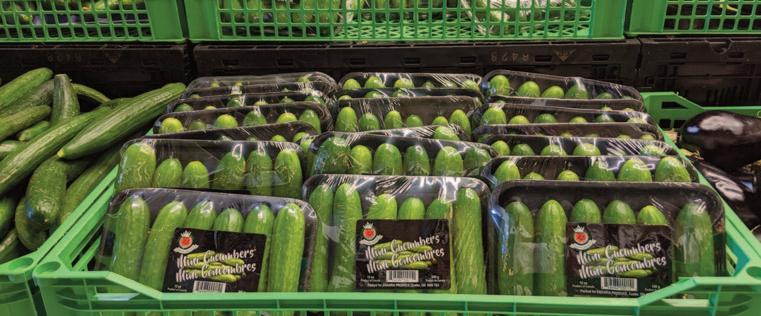
On July 7, 2023, the Canadian Food Inspection Agency (CFIA) published a notice informing the fresh produce industry of changes to the Canadian Grade Compendium: Volume 2 – Fresh Fruit or Vegetables.

These changes reflect feedback received from industry, trading partners, and stakeholders, during the consultation period covering:
• A new standard for greenhouse miniature seedless cucumbers.
• Updates to the grades and requirements for greenhouse long seedless cucumbers, including changes to size requirements and clarifications to terminology for defects and tolerances.
The modified and new standards are
found in the following:
• Part 2 Grade Requirements for Fresh Vegetables.
• Grades and Requirements for Greenhouse Long Seedless Cucumbers, paragraphs 148-154.
• Grades and Requirements for Greenhouse Miniature Seedless Cucumbers, paragraphs 200-206.
The CFIA is providing industry with sufficient time to adjust product grading and labels. The transition period began July 7, 2023 and ends on January 6, 2024.
As of January 7, 2024, the previous grade requirements will cease to apply, and all regulated parties must comply with the new requirements. Consult the notice to industry to learn
more.
Questions or concerns can be sent to cfia.labellingconsultation-etiquetage. acia@inspection.gc.ca. Publication of an
Bumblebee research sparks rapid industry change
KRISHNA RAMANUJAN
A Cornell study that revealed commercial eastern common bumblebee hives pose a threat to their wild counterparts has led one major pollination company to quickly adapt the bumblebee hive boxes they ship to growers.
The study, which published in February in the Journal of Applied Ecology, showed that brightly coloured commercial bumblebee nest boxes attract wild queens, who may be seeking to establish their own nests. When wild queens enter these nest boxes, workers treat them as invaders and kill them, which causes losses of wild hives – and valuable pollinators – in those areas.
The study also found that
attaching an existing device –called an excluder – to the nest box doorways, was 100 per cent effective at preventing wild queens from entering hives.
The company, Plant Products, a North American subsidiary of Biobest, has already provided excluders for the entrances and exits of all hives it ships, along with excluder operating instructions. In addition, a product manager has called every client to explain the use of the excluder, which makes a doorway too small for large queens, but big enough for workers.
“For every queen that we’re losing because of this behaviour, that’s a whole colony of bumblebees that we’re potentially losing that’s providing really important pollination services later in the season,” said Heather Grab,
Ph.D. ’17, senior lecturer in the School of Integrative Plant Science in the College of Agriculture and Life Sciences, and the paper’s corresponding author. Olivia Miller ‘21, who worked on this research as part of her undergraduate thesis, is the paper’s first author.
“From what we see in our data, it’s an average of about 10 queens per colony that are being killed, and that’s just in our study region,” she added.
The study also found that pollination services actually declined at sites where commercial bumblebee colonies were used, compared to areas where they were not used. The scientists suspect that the drop in services was due to the loss of wild pollinators.
A few months prior to the
updated standard for greenhouse tomatoes is expected in the coming months.
Source: DRC August 1, 2023 newsletter
paper’s publication, co-author Scott McArt, Ph.D. ’12, associate professor of pollinator health in the Department of Entomology (CALS) and manager of the Dyce Lab for Honeybee Studies, contacted Plant Products and Koppert, the only two North American commercial bumblebee suppliers, to tell them about their findings and how excluders offer a simple and effective solution. By the time the paper published in February, Plant Products was already prepared to add excluders to all its shipments. The company has also started research and development to evaluate optimal strategies going forward.
“Frankly, I’ve been blown away by how quickly Biobest responded to the study’s findings and implemented simple but effective companywide changes,” McArt said.
The excluders were originally developed for a completely different purpose, but came in handy when the Cornell researchers made their discovery. Commercial bumblebee nest boxes come with two openings, which serve as an entrance and an exit for the bees. The openings
can be slid shut, so if growers spray their crops, they can close the exit to keep bees in but leave the entrance open for bees out foraging to return. Also, if growers want to move a hive, they can close both openings and reopen them in a new location.
Excluders were originally developed to cover just the exit, to prevent commercial hive queens from escaping and mating with wild bees and mixing genes, and/or spreading disease. No one expected they would be needed to keep wild bees out. Now Plant Products is using the excluders on both the entrances.
Overall, bumblebees have been experiencing population declines throughout North America, so saving queens early in spring has a high potential to stem some of those declines, McArt added.

PAGE 6 –– SEPTEMBER 2023 THE GROWER
Katja Poveda, associate professor of entomology in CALS, was also a coauthor of the paper. This article is published courtesy of the Cornell Chronicle.
Researcher Heather Grab holds an excluder next to a commercial bumblebee nest box. Photo by Ryan Young, Cornell University.
GREENHOUSE GROWER
Diagnosing diseases: from sampling to making informed management decisions
KATIE GOLDENHAR
Every year seems to throw a curveball at growers and 2023 has been no different. For field horticulture growers, the deluge of rain has increased the presence of many summer diseases. In covered horticulture production, diseases such as powdery mildew, viruses, and root rots are always top of mind for management.
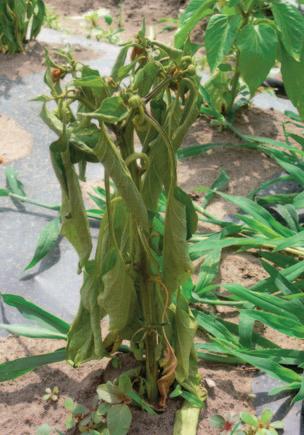
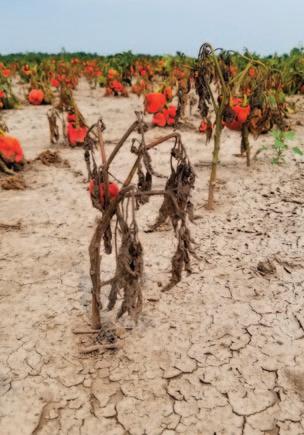
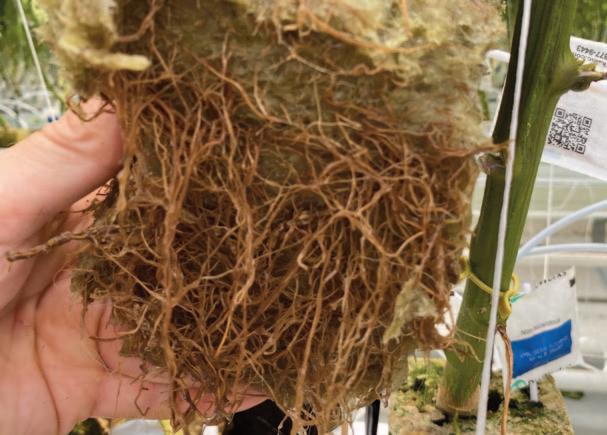
Plant diseases are caused by microscopic organisms, known as pathogens, (including fungi, bacteria, viruses, oomycetes, nematodes) making them inherently difficult to confidently diagnose. Symptoms are a plant’s expression of a pathogen infection, such as wilting, leaf spots, galls, and fruit rot. Disease symptoms can be easily confused with nutrient deficiencies, environmental stressors or even insects. Signs are the actual organism or biproduct of the organism, such as mycelium, fungal fruiting bodies or bacterial ooze, and signs can confirm that a symptom is caused by an infection of a pathogen. In many cases signs are not present, and we are left to figure out what is going on. Some diseases, such as powdery mildew (figure 1), we can diagnose based on the symptoms and signs alone, but many diseases, such as root rots (figure 2), can be challenging to diagnose based on symptoms alone.
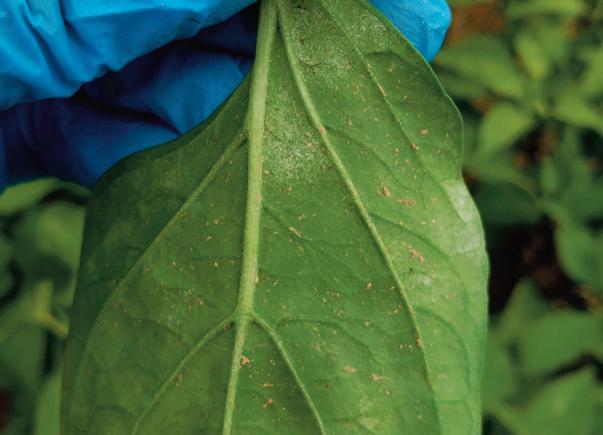
Why does it matter what is causing the disease? Pathogens or causal agents will have different control options. While some management will be effective at reducing most diseases, such as
crop rotation or clean out, other techniques such as crop protection products or environmental manipulation often vary depending on the pathogen.
To best inform management decisions, diagnosing a suspected disease can require the help of a diagnostic lab. Diagnostic labs have the expertise and equipment to identify these microscopic organisms. This can be done with basic microscopic analysis of physical structures such as spores or by using molecular analyses such as ELISA or PCR.
There are pros and cons to all methods but in general, a reputable lab will know what methods are needed or not based on the information they receive. For example, water samples taken before and after treatment to determine if the treatment system is working are important to have tested for viability via plate testing vs only genetic
analysis. The genetic analysis will detect both dead, non-viable and living DNA of the pathogen. This should be specified on a submission form.

Quality results from a diagnostic lab require quality samples to be sent in and supporting information to help inform the diagnostician of the issue. Figure 3a shows a dead plant that is not suitable for figuring out the issue. Dead plant tissue will always be full of saprophytic (or secondary) fungi which will be detected in the diagnosis but aren’t the primary pathogen causing the problem.
Figure 3b shows a declining plant that will have fewer organisms present and the main pathogen will be easier to diagnose.
To learn more about diagnosing diseases and making informed management decisions, register for the Canadian Greenhouse Conference where I will discuss best sampling

practices for plants and water, reviewing modern lab diagnostics and report interpretation and limitations. For greenhouse vegetable growers, the session is at 2pm on Wednesday and for floriculture growers the session
starts at 9am on Thursday.

THE GROWER SEPTEMBER 2023–– PAGE 7
Katie Goldenhar is pathologist-horticulture for the Ontario Ministry of Agriculture, Food & Rural Affairs.
Figure 2. Rotten roots on pepper (photo credit: Cara McCreary)
Figure 1. powdery mildew on pepper
Figure 3. a) a dead pepper plant (photo credit: Amanda Tracey), b) a pepper plant with early signs of decline
Promoting Ontario as a preferred destination for international farm workers
place with Mexico and countries in the Caribbean. One of our primary goals with these audiences is to promote Ontario as a preferred destination for workers and the OFVGA as a trusted partner to ensure well-functioning processes and programs.
Labour has long been – and continues to be – a high priority issue for the Ontario Fruit and Vegetable Growers’ Association (OFVGA). Currently, a key focus for our labour section is building relationships with new countries that could be sources of reliable, high-quality offshore workers. This was a clear direction provided by growers through a resolution passed at the OFVGA annual meeting last winter. The issue was also discussed at the
Fruit and Vegetable Growers of Canada annual meeting this past March 2023.
To that end, we are in the early stages of actively exploring options for expanding Ontario grower access to workers from countries in Central America and beyond, similar to significant expansion in recent years of the ag stream of the federal Temporary Foreign Worker (TFW) program for workers from Guatemala.
At the same time, we are also working to strengthen the long-standing international partnerships that are already in
We recognize that we’re not the only destination available to seasonal and temporary farm workers, so it’s important to raise awareness of what Ontario has to offer. That includes making international governments aware of the resources available to support workers here and the investments by farm employers and our federal and provincial governments in worker safety, protection and well-being.
As well, we are unique in our ongoing efforts through the More than a Migrant Worker initiative to promote the value of international workers, our appreciation of their contributions to our country and giving them the opportunity to share their stories in their own words.
Recently, both of us had the opportunity to participate in a delegation that was visiting Jamaica, a country that
contributes approximately one quarter of Ontario’s seasonal and temporary farm workers every year. It was a valuable experience for us to get a better understanding of how both Jamaican workers and the Jamaican government perceive our programs and gain some insights into the program dynamics from their perspective.
As part of the trip, we were able to attend an information session hosted for Jamaicans interested in working in Canada. It was extremely well-attended and along with fellow growers who were also part of the delegation, we were able to highlight the many things our industry is doing to make Ontario a region of choice and help workers have a beneficial and positive experience while they are here.
The highlight of the trip, however, was an introduction to the Jamaican minister of agriculture, as well as an in-depth meeting with Jamaica’s minister of labour, where we had positive discussions about the value of Canadian farm jobs to both of our countries.
We hope to build on this
initial meeting with continued dialogue about how we can further improve the program, enrich orientation and training opportunities for workers before they travel to Canada and use the More than a Migrant Worker initiative to more widely share the stories and perspectives of Jamaican farm workers.
An important additional benefit was learning about the mechanics of being part of an international delegation. This will be useful as we move forward with building relationships with new source countries and promote our employment opportunities in the fruit and vegetable sector to them.
As we look to the future of our industry, we know it’s important to expand our labour pool so we can meet the increasing need for international workers and ensure growers have options in case access to any existing source countries is interrupted or diminished for some reason.
Bill George is the chair of the OFVGA Labour Section and Stefan Larrass is a senior policy advisor with OFVGA.

In Ontario, the hop crop is progressing normally. In the southwestern reaches of the province, growers started harvesting early and mid-season cultivars in mid-August. Harvest timing is important in order to preserve hop quality says Evan Elford, new crop development specialist for the Ontario Ministry of Agriculture, Food and
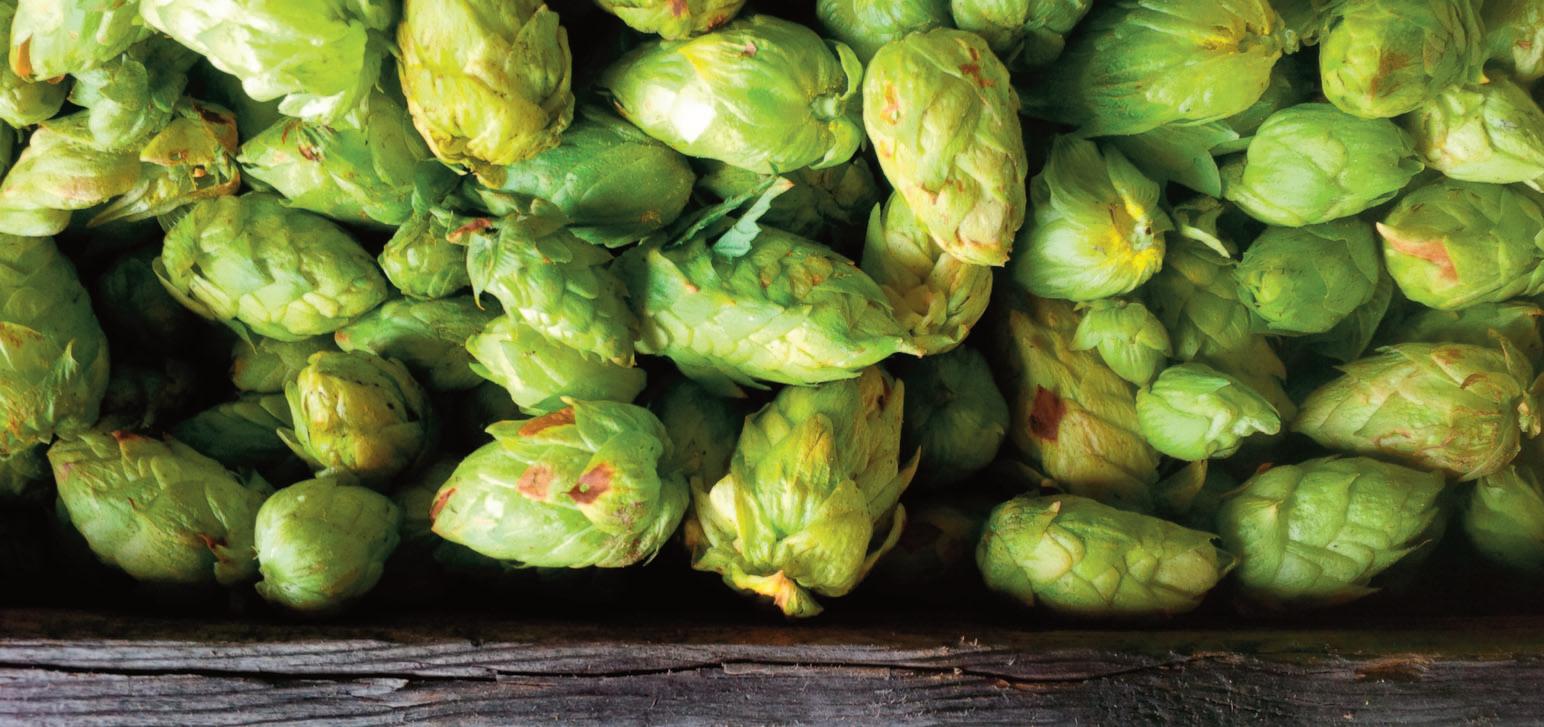
STAFF
Publisher: Ontario Fruit and Vegetable Growers’ Association
Editor: Karen Davidson, 416-557-6413, editor@thegrower.org
Advertising: Carlie Melara 519-763-8728, advertising@thegrower.org
The Grower reserves the right to refuse any advertising. Any errors that are the direct result of The Grower will be compensated at our discretion with a correction notice in the next issue. No compensation will be given after the first running of the ad. Client signature is required before insertion.
The Ontario Fruit and Vegetable Growers’ Association is the sole owner of The Grower. All editorials and opinions expressed in The Grower are those of the newspaper’s editorial staff and/or contributor, and do not necessarily reflect the view of the association. All rights reserved. The contents of this publication may not be reproduced either whole or in part without the prior written consent of the publisher.
OFFICE 355 Elmira Road North, Unit 105 Guelph, Ontario N1K 1S5 CANADA
• Fax 519-763-6604
Tel. 519-763-8728
The Grower is printed 12 times a year and sent to all members of the Ontario Fruit and Vegetable Growers’ Association who have paid $30.00 (plus G.S.T.) per year for the paper through their commodity group or container fees. Others may subscribe as follows by writing to the office:
$30.00 (+ HST) /year in Canada
$40.00/year International
Subscribers must submit a claim for missing issues within four months. If the issue is claimed within four months, but not available, The Grower will extend the subscription by one month. No refunds on subscriptions.
P.M. 40012319

ONTARIO FRUIT AND VEGETABLE GROWERS’ ASSOCIATION BOARD OF DIRECTORS 2023
MANAGEMENT COMMITTEE
Shawn Brenn, Waterdown Vice-chair Mike Chromczak, Brownsville
PAGE 8 –– SEPTEMBER 2023 THE GROWER
BILL GEORGE & STEFAN LARRASS
PERSPECTIVE
Chair
Grapes Matthias Oppenlaender, NOTL Fresh Veg Joann Chechalk, St Anns Small fruit/Berries Morris Gervais, Springwater BOARD OF DIRECTORS Apples Cathy McKay, Port Perry Fresh Veg other Joann Chechalk, St Anns Tender Fruit Dave Enns, Niagara-on-the-Lake Asparagus Mike Chromczak, Brownsville Grape Matthias Oppenlaender Fresh Veg muck Quinton Woods, Cookstown Potato Shawn Brenn, Waterdown Small Fruit/Berries Morris Gervais, Springwater Ginseng Glen Gilvesy, Tillsonburg Greenhouse Jan VanderHout, Dundas Greenhouse George Gilvesy, Tillsonburg Processing Vegetables Tracy Gubbels, Mount Brydges OFVGA SECTION CHAIRS Crop Protection Brian Rideout Environment and Conservation Jan VanderHout Labour Bill George Safety Nets Mike Chromczak Energy, Property, Infrastructure and Food Safety Brian Gilroy
VANE
WEATHER
Rural Affairs. Photo by Glenn Lowson.
BILL GEORGE STEFAN LARASS
Diversity keeps this family operation buzzing
more than the orchard. Rather, it’s about being nimble, being present . . . and being diversified.
Apples are indeed a mainstay of Curtis Orchards’ output. Loyal customers take home bushel after bushel of apples – especially Golden Delicious, if they’re making apple sauce – either handpicked from the 25-acre orchard or supplied by other local growers to help meet demand.
U.S. apple production is expected to increase at least 10 per cent this year, thanks mainly to a bounce-back year in Washington. That’s making up for Michigan’s ho-hum production and declines in parts of the Midwest.
For example, in areas such as central Illinois, a troubling April frost took its toll on operations like the Curtis Orchard and Pumpkin Patch, a wellestablished family farm and storefront business on the outskirts of Champaign.
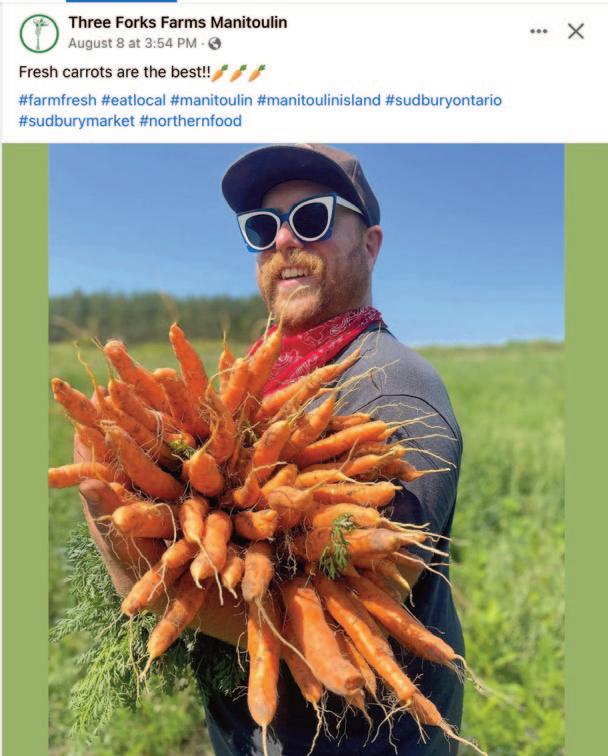
Production will likely drop at this establishment by 10-15 per cent this year, says family member and beekeeper Rachel Coventry.
And that’s concerning for matters such as trying to forecast labour needs for the fall harvest, not to mention the management challenges that come with decreased revenue.
But if there’s one thing the Curtis family knows, it’s that their operation’s appeal is about much



However, apples are just part of the multi-faceted experience that draws a half-million visitors annually to the operation, from the third week in July until Christmas, and routinely causes traffic lineups on the otherwise quiet two-lane county road that passes by.
Being conveniently located within a stone’s throw of the twin cities of Champaign and Urbana (pop. 225,000) and the University of Illinois main campus definitely helps draw crowds.
But it’s the diversity that Rachel considers Curtis Orchard’s key overall feature, with everything from pickyour-own to pony rides.
“We offer many attractions,” she says. “People come to take it all in.”
That’s clear from the moment you pull into the orchard’s grassed and paved parking areas. A Wizard of Oz theme distinguishes many of the features; early on, Rachel’s father Randy thought a peaked,
corrugated steel grain silo that was already onsite looked a bit like the classic movie’s Tin Man, and had it painted accordingly. Today, a wide brick pathway painted yellow (i.e., the Yellow Brick Road) passes by the bin, leading visitors to an expansive 2,000 sq ft country store where the operation’s storied apple cider doughnuts and Rachel’s orchardproduced, award-wining honey are popular.
There’s more. The retail outlet shares space with the Flying Monkey Café, which offers hot lunches (including pulled pork, Italian beef and bratwurst) from 11 a.m. – 2 p.m. every day during harvest.
Access to these parts of the operation, along with a playground and petting zoo, is free. At harvest, visitors can pick their own apples and pumpkins. Who knew that Illinois produces more pumpkins than any other state?
Beyond the retail store, the operation earns additional income through ticketed features, including mini-golf, wagon rides, pony rides, a corn maze and a rope maze.
Curtis Orchard switched from staff-guided tours to self-guided
tours after COVID, to spread out crowds and save on labour. Rachel says the transition has been successful; visitors report appreciating the opportunity to wander at their own pace, rather than being part of a regiment.
Diversification – along with hard work and commitment -has long been a staple for the Curtis family, which traces its local roots back to 1873 when family members settled on 80 acres southwest of the city. Up until the 1950s, they grew corn, soybeans and hogs.
The family grew at the same time. But with relatively small acreage, and more mouths to feed, they knew something had to give. So in 1977, they started diversifying the operation by growing apples. They began with 700 trees on three acres, then added another 1,700 trees in 1978 (today, they have 2,000 trees on about 25 acres). Around 1990 they started making their orchard a public destination, and it’s blossomed from there.
Rachel’s interest in bees and honey production also lends itself well to the operation’s diversification. She has become an accomplished apiarist; last
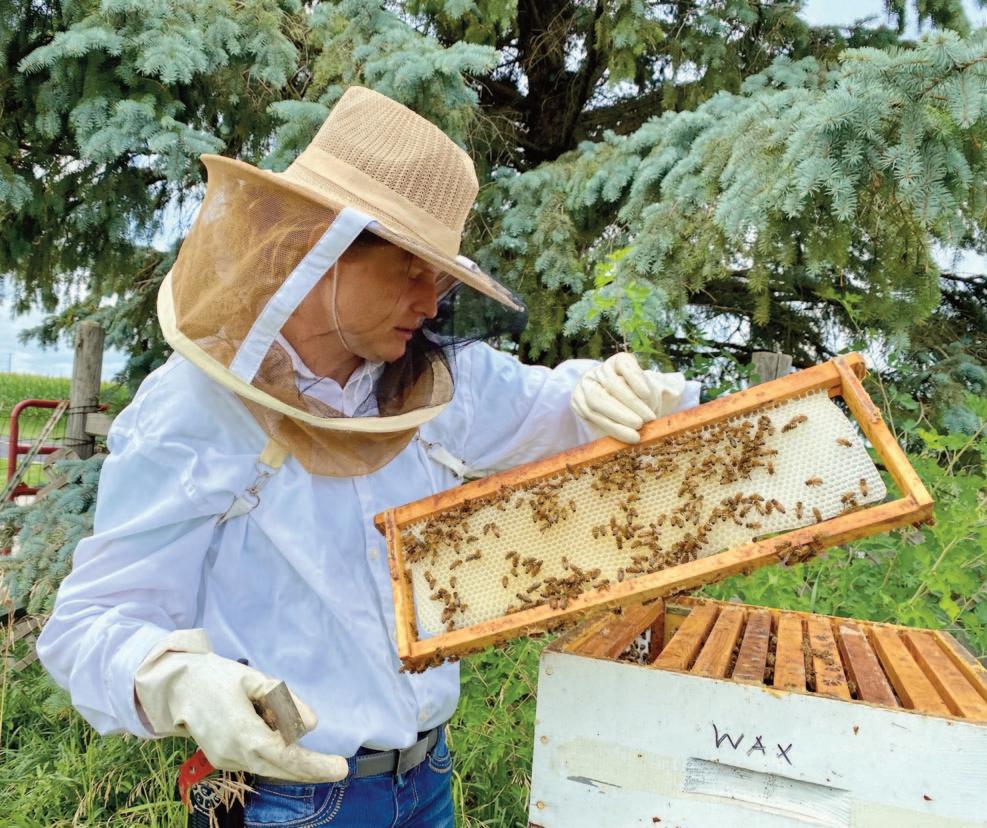
year, with the help of mild weather, tarps and straw bales for hive insulation and other wind reduction approaches, she was able to nurture her 14 hives through the winter with no losses (she usually experiences about a 30 per cent loss).

That success bodes well for orchard pollination, for supplying the operation’s steadily growing client base with award-winning honey…and for ensuring diversification helps fuel Curtis Orchard production for generations to come.
“We hope people will drop by for a visit if they’re ever in this area,” says affable beekeeper Rachel. Indeed, witnessing this successful operation first-hand would be a good investment of time for growers everywhere.
Owen Roberts is a past-president of the International Federation of Agricultural Journalists and a communications instructor at the University of Illinois

SEPTEMBER 2023–– PAGE 9 THE GROWER THE URBAN COWBOY
Photos by Owen Roberts.
OWEN ROBERTS
@growernews
SCENE ON TWITTER-X
thegrowernews
Diversification – along with hard work and commitment -- has long been a staple for the Curtis family
“
~ RACHEL COVENTRY
GOVERNMENT POLICY
Input sought from growers on proposals for aggressive plastic packaging reductions
COMING EVENTS 2023
Sept 6 Ontario Grape Grower Demo Day
Sept 6-8 Asia Fruit Logistica, Hong Kong
Sept 9-10 Stratford Kiwanis Garlic Festival, Stratford, ON
Sept 12-14 Canada’s Outdoor Farm Show, Woodstock, ON
Sept 13 Grape Growers of Ontario Celebrity Luncheon, Roma Club, St. Catharines, ON
Sept 13 Berry Growers of Ontario Twilight Meeting, Blueberry Hill Estate, St. Williams, ON
Sept 20 Ontario Produce Marketing Association Annual Golf Tournament, Lionhead Golf & Country Club, Brampton, ON
Oct 2-8 Ontario’s Agriculture Week
Oct 4-5 Canadian Greenhouse Conference, Niagara Falls, ON
KAREN DAVIDSON
Environment & Climate Change Canada (ECCC) has published a consultation document called “Pollution prevention planning notice (P2) for primary food plastic packaging: targets for reduction, reuse, redesign and recycled content.”
While the produce industry has moved quickly to meeting targets on recycled content, the new proposed rules would have a major impact on the produce industry in Canada – a sector that’s responsible for only two per cent of plastic use in the country. The Canadian Produce Marketing Association (CPMA) is most alarmed that produce
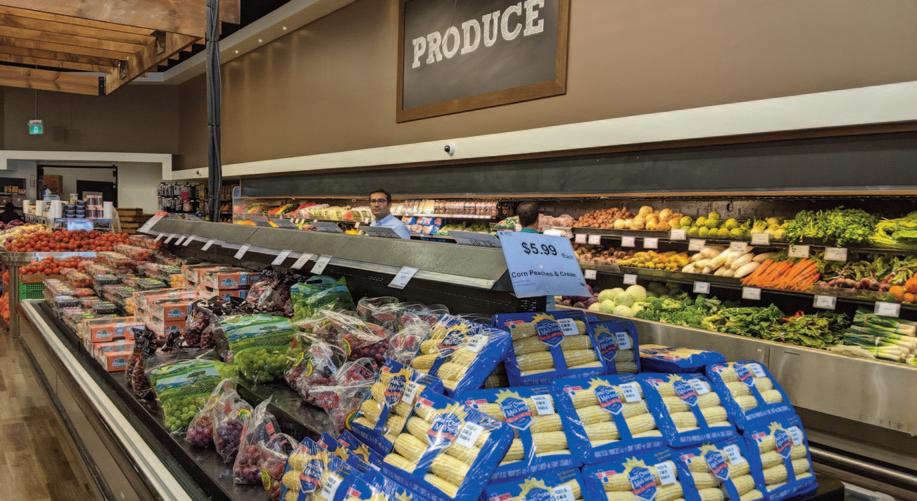
companies would be required to have fresh fruits and vegetables distributed and sold in bulk and/or plastic-free packaging with targets of 75 per cent reduction of plastic by 2026 and 95 per cent by 2028.
In addition, the federal government plans to ban noncompostable PLU stickers by 2030 – a regulation that would add an additional estimated cost of $30 million to move to PLU stickers with certified adhesives, ink and substrates. In two other European jurisdictions, similar regulatory efforts have been legally challenged and met with limited success due to the challenges with certifying all three elements of the PLU sticker as compostable.
The P2 Notice would require Canada’s largest grocery retailers that generate grocery retail sales in Canada of more than $4 billion annually to prepare and implement a P2 plan to meet targets for reduction, reuse, and redesign of primary food plastic packaging, including recycled content targets.
“While this looks like a retail only requirement it is truly a full supply chain change to how we pack, ship and sell fresh fruit and vegetables in Canada and from around the world,” explains Ron Lemaire, president, CPMA. “This plan has the potential to impact access and availability of produce in Canada, impacting cost, food inflation, food loss/waste and food security.”
Lemaire continues: “The federal government is asking for changes that are not aligned with how the global food system works and conflicts with policy frameworks already in place. The goal of reducing plastic by 75 per cent by 2026 is not achievable. The assistant deputy minister of ECCC has been briefed, but it’s important to put on the record that hiding behind a politically driven agenda is not an acceptable answer to developing policy that undermines food availability and negatively impacts Canadians.”
The federal government’s 30-day consultation period ends August 30, 2023.
“Grower input on this consultation will be vital to frame the unintended consequences of moving forward with these proposed targets and our need to have produce exempt from the proposed rule,” says Lemaire.

CPMA has prepared a one-pager with key questions that growers should be addressing. if you have questions please contact Jane Proctor (jproctor@cpma.ca) or Ron Lemaire (rlemaire@cpma.ca)
For the federal government’s consultation document, link here: https://rb.gy/02dzk
Oct 17-18 Canadian Centre for Food Integrity Public Trust Summit, Westin Airport Hotel, Toronto, ON


Oct 19-21 PMA Fresh Summit Convention & Expo, Anaheim, CA
Nov 3-12
Royal Agricultural Winter Fair, Toronto, ON
Nov 14 Arrell Food Summit, Toronto, ON
Nov 16 Farm and Food Care Annual Harvest Gala, Milton Banquet & Conference Centre, Milton, ON
Nov 19-21 Advancing Women in Agriculture Conference, Sheraton Fallsview, Niagara Falls, ON

Nov 20-22 Potato Growers of Alberta Conference & Trade Show, Grey Eagle Resort & Casino, Calgary, AB
Nov 22-26 Canada’s Outstanding Young Farmer National Event, Laval, QC
Nov 24 Ontario Produce Marketing Association Annual Gala & Awards Ceremony, Bellvue Manor, Vaughan, ON
Nov 29
2024
CanAgPlus Annual General Meeting VIRTUAL
Jan 10-11 Potato Expo. Austin, Texas
Jan 24-27 Guelph Organic Conference, Guelph, ON
Jan 28-31
Feb 5-9
North American Strawberry Growers’ Association Meeting & Conference, Hershey, PA
Global Minor Use Summit IV, Madrid, Spain
Feb 7-9 Fruit Logistica, Berlin
Feb 20 Ontario Fruit & Vegetable Growers’ Association Annual General Meeting, Niagara Falls, ON
Feb 21-22
Ontario Fruit & Vegetable Convention, Niagara Falls Convention Centre, Niagara Falls, ON
March 5-7 Fruit & Vegetable Growers of Canada Annual General Meeting, Ottawa
April 23-25
May 30
June 11-13
Canadian Produce Marketing Association Convention & Trade Show, Vancouver, BC
International Potato Day
GreenTech Amsterdam, RAI Amsterdam, Netherlands
THE GROWER PAGE 10 –– SEPTEMBER 2023
SCENE ON TWITTER-X
@growernews thegrowernews
RETAIL NAVIGATOR
Retailers invest in boots in the field
PETER CHAPMAN
Nothing compares to visiting a vineyard, pulling off a grape and savouring the sun-drenched fruit. If you’re a liaison between growers and a retailer employer, that’s a perk of a demanding job. That’s the moment when it all becomes real.
A number of retailers have invested in personnel to visit growing regions throughout the season. Sobeys has supplier development leads. At Loblaw, they are called vendor development managers. At the core of the position is that they are the link between primary producers and the merchandisers in the corporate office. With centralized procurement, it is challenging for category managers to get out and see producers across the country. So these liaisons are essentially the retailers’ eyes and ears in each production area.
It is positive for both growers and retailers to have personal interaction in the field where there’s a first-hand understanding of what is happening. Too much
rain? Droughty conditions? Pest pressure? As a grower, you can send emails, photos and even videos, but there is nothing better than actually standing in the field or the packing shed to understand how environmental conditions are affecting sizing and quality. Be proactive with these liaison people and set up as many visits to your farm as possible through the season. They are on the road a lot, so try to understand when they will be close to you and make yourself available. These folks are tasked with sharing the information with the merchandisers, so they can keep the right amount of product flowing when it is required.
Retailers want more up-to-the minute forecasts and the people visiting your farm must understand why growers might have more or less produce than forecasted.

I recall taking a Loblaw vendor development manager to a field of onions when Stemphylium blight was relatively new. He could not believe the devastation. It is one thing to say it in an email and it is another to stand in the field.
Many positives to people in the fields
Obviously standing in the field or orchard or vineyard is the biggest positive but there are many others to consider. Many growers I have talked to believe this liaison role puts someone ‘on their side’ to ensure the people in the office do know what is happening out in the field.
Metro Moi is taking off
Canadian Grocer is reporting that Metro’s rewards program is taking off. Three months after a soft launch in Québec, the grocer has added one million members to Moi, with a total of 2.2 million members across five banners: Metro, Super C, Première Moisson, Brunet and Jean Coutu.

What’s gratifying to CEO Eric LaFleche is that Metro is observing a higher basket spend from Moi customers across all banners. In a call with investors,

Another benefit is these field people know what retailers are looking for and they can see possibilities you might miss. New opportunities might be in varieties, packaging or other initiatives that could improve sales in their stores. Growers do not always know the direction a retailer is going so these liaisons can streamline the process.
Often, producers perceive that their customers do not appreciate everything they are going through to get the crop planted, harvested and packed. When these people visit your operation, they can see all the different steps to when a product leaves the farm gate.
If have introduced new forms of pest management or irrigation to combat drought, then show them. These experiences will improve your relationship because the message back to the office is more detailed and nuanced. The liaison will explain what you’re going through and what efforts or solutions are in place.
If are developing new opportunities such as variety trials or production processes, keep them aware of the progress. They will probably share this news with the category team. It’s a chance to get traction with the new products or processes you are working on.
Vendor development roles are a big asset to growers outside the geography where merchandisers are working. The further away your farm is from the office, the more these people can help.

Other considerations
Growers should understand that with these liaison people travelling more and comparing notes, more intelligence will be gathered on what you might be working on for another retailer. Clearly, these projects are between you and your customer, but you should decide in advance how much you share.
Every retailer is focused on efficiency, so adding the costs of field travel increases operational costs which must be paid for with the margin on products at retail. For every grower, a field visit from a retailer representative is an opportunity to build trust.
And what is trust? The
Harvard Business Review says that trust has three core drivers: authenticity, logic and empathy. People tend to trust you when they believe they are interacting with the real you (authenticity), when they have faith in your judgment and competence (logic) and when they feel that you care about them (empathy).
Peter Chapman is a retail consultant, professional speaker and the author of A la Cart-a suppliers’ guide to retailer’s priorities. Peter is based in Halifax, N.S. where he is the principal at SKUFood. Peter works with producers and processors to help them get their products on the shelf and into the shopping cart.
LaFleche reported that sales reached $6.43 billion, up 9.6 per cent compared to a year ago. Food inflation is moderating to about eight per cent, he said, but price increase requests remain higher than normal.
At press time, Metro was still dealing with a strike of 3,700 workers in the Greater Toronto Area. Since July 29, there are 27 stores impacted.
STARTUPS & SMART TECHNOLOGY
OCTOBER 2023
BOOK AD SPACE SEPT 16, 2023 • AD COPY DUE SEPT 20, 2023
Purchase 1/4 page ad and receive complementary editorial coverage. advertising@thegrower.org
THE GROWER SEPTEMBER 2023–– PAGE 11
Retailers have representatives on the ground testing brix of fruit in season. In this case, yellow plums are examined.
FOCUS: GREENHOUSE INNOVATION
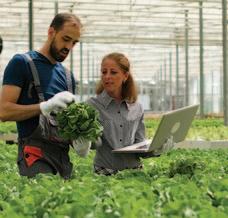

Robotic picking carts provide reliable efficiency data

KAREN DAVIDSON
Lebo Farms was one of the first in North America to install robotic picking carts in their 52acre pepper greenhouse in Leamington, Ontario. That was in 2019. Four years later, the innovation has proven its worth in more accurate tracking data, by picker, by row and in less bruising of peppers.

“I had seen something similar in a tomato greenhouse in Holland,” explains Jake Neufeld, owner/operator, Lebo Farms. “But I was convinced from company videos that this technology was a proven system in peppers.”
Belgian company Bogaerts has designed a cart that fits the narrow rows but more importantly can be raised as the peppers grow higher on the trellis system. Pickers no longer tumble their harvest down a chute to a picking cart. They pick right into the cart at waist height, ensuring the integrity of the pepper. Once the cart is full, the picker pushes a button to send the cart to the warehouse. No person is required

to organize and move carts.
What’s most futuristic is that the carts are programmed to move in tandem with other carts via an induction wire embedded in the concrete from the greenhouse to the packing line in the warehouse. Once the cart arrives in the warehouse, it is weighed and tracked by an
identifier code.


“With the touch of a button that programs the start and end points, the carts maneouvre themselves,” says Neufeld. “This is beneficial in high-yielding periods when peppers may be picked 12-13 hours per day. We have carts in the buffer area where they are stored for the start
of the packing line the next morning.”
Lebo Farms has a financial analyst on staff who provides weekly reports on kilos/hour picked and other ratios which indicate qualitative features. These statistics help to calculate labour rates.


“We’re more reliant on technology to work with us,” says Jarrod Hall, chief financial officer, Lebo Farms. “We have confidence in the system to provide reliable data.”
In fact, the data supports the pickers in the warehouse who are doing a good job of harvesting
high-quality peppers. Greenhouse supervisors provide immediate feedback on percentage of discards. This incentivizes workers to pick the best fruit and not deformed fruit that will be thrown out on the grading line.
Pick right, first time. That’s a guiding principle in the greenhouse sector where temporary foreign workers are so important. Interestingly, automation is making those workers more efficient. At Lebo Farms, 18 pickers expertly spot the best fruit,

THE GROWER PAGE 12 –– SEPTEMBER 2023
while 55 carts trundle along with no complaint.
Jake Neufeld, (L) owner/operator, Lebo Farms and Jarrod Hall, chief financial officer, demonstrate the Bogaerts picking cart that’s ready to work in 52 acres of greenhouse peppers, Leamington, Ontario. Photos by Marcella DiLonardo.
A worker positions the cart in the pepper row.
Several carts move at walking pace, 110 meters per minute, from the greenhouse to the warehouse, via an induction wire embedded in the concrete floor.
Each cart is weighed at the warehouse, identified by picker and row, before transitioning to a buffer area. Carts are stacked overhead, ready to enter the packing line.
FOCUS: GREENHOUSE INNOVATION





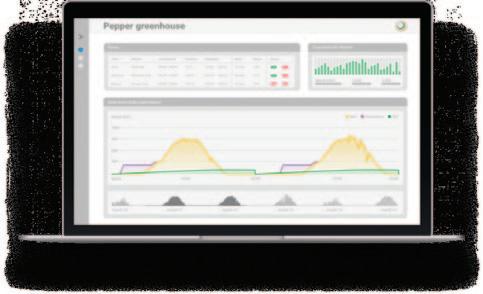
Autonomous cart treats strawberries with UV light to control powdery mildew
KAREN DAVIDSON
The drive towards automation is quickening. Look no farther than Bogaerts Greenhouse Logistics, based in Belgium. The company unveiled its solution for treating powdery mildew in strawberries at Fruit Logistica in February 2023. The choice of the UV-C technology is backed by five years of development at the


Research Centre Hoogstraten.
The Qii-Drive Shift UV-C is an autonomous driving machine that provides a residue-free, biological solution against powdery mildew. The machine can treat 10 acres during one night depending on the gutter setup. Company representatives say that battery capacity and the amount of dark hours during the night are the limiting factors.

The machine is easy to install


Every greenhouse is different in its construction, in its crops and in its climate control systems. But every operation, particularly in southern Ontario, must be prepared to cope with high humidity and extreme temperatures of 30°C-plus in summer. That’s why highpressure fogging systems are becoming important to lower temperatures by up to 6°C-7°C says Freddy Sarkis, a representative of MJ-Tech Fogging Systems, based in Leamington, Ontario.
“2023 has been a cooler summer,” says Sarkis. “However, we have installed fogging systems for about 200-300 acres of cucumbers, peppers and some strawberries.”
The benefits are not only to strengthen plant health but
in any greenhouse with a tuberail system. The machine is equipped with flashing lights, stop bumpers, audio signals, sensors and safety scanner. Bogaerts has years of experience in the development of self-driving vehicles for greenhouse farming and is the market leader in this field. For more information, link to this YouTube video: https://www.youtube.com/watch?
v=FrN-yQyGpSg
to provide a much cooler climate for the greenhouse workers. The goal is to decrease plant stress so that the plant is less vulnerable to fungi, viruses and insect pests. High-pressure fogging will affect temperature, relative humidity, humidity deficit and Vapour Pressure Deficit (VPD) and plant temperature. Relative humidity and vapour pressure deficit are two different ways to measure humidity. Relative humidity measures how saturated the air is with moisture, at a certain temperature. Vapour pressure deficit, on the other hand, measures the difference between saturation and the current amount of moisture in the air, in terms of pressure. The pressure described in VPD is what drives plant transpiration, making it a much better proxy for nutrient transport and
therefore, plant activity.
High VPD values may result in the closure of the plant’s stomata and block transpiration. If that happens, then the uptake of calcium will be reduced, resulting in stunted plant development and fruit quality issues.
Freddy Sarkis explains that the 575-600V MPU-40 version of the high-pressure fogger is developed specifically for the Canadian market. It is particularly valuable because it does not require investment in a transformer. Most other high-pressure fogging suppliers would require a transformer because they are not 575-600V. What’s more, with local inventory, the MJ-Tech Fog System can be configured-to-order to ensure good lead times.
SEPTEMBER 2023–– PAGE 13 THE GROWER
fogging
temperatures
improve plant and worker
(+1) 866-220-5455 INFO@SOLLUM.TECH Only SUNaaS can power a fully dynamic grow light. Our proprietary SUNaaS platform monitors ambient light to adapt our LED grow lights spectra and intensity to match the light recipe at all times. (+1) 866-220-5455 INFO@SOLLUM.TECH SOLLUM.TECH a Only SUNaaS can power fully dynamic grow light. Our proprietary SUNaaS platform monitors ambient light to adapt our LED grow lights spectra and intensity to match the light recipe at all times. ©2023 Sollum Technologies. All rights reserved. SUN as a Service, LED by nature, SF-ONE, SF-PRO, SF-MAX and the Sollum logo are registered or trademarks of Sollum Technologies. There’s dyanmic lighting... and Sollum’s fully dynamic solution. The difference? Automatic dimming in real time, thank to SUN as a Service® (SUNaaS) cloud platform. Energy savings. Only use the amount of light neccesary to grow the best produce. Better produce taste and appearance, and longer shelf life. (SUNaaSTM Automatic dimming in real time a key feature of SUN as a Service® ) cloud platform. Unlimited multi-zone light management with each zone lit with a custom light recipe. A future-proof solution able to integrate new technologies and innovations. Made in Canada ® Scan to learn more
High-pressure
systems lower
to
health
Keeping beetles out of berry fields
ERICA PATE
Japanese beetle, Popillia japonica, is a common pest familiar to many berry growers. These beetles feed on leaves and fruit, causing characteristic shredded and skeletonized leaves, defoliation, and direct damage to berries (Fig 1 & 2). The beetles are easy to find, often on leaves of the upper parts of raspberry canes or upper parts of the blueberry bush. Adults begin to emerge in late June-early July, and live for 30-45 days. They can be found on raspberries into September.
Japanese beetles can be difficult to manage because they are highly mobile and continue to fly into berry fields through the summer. There are a few insecticides registered for control on berry crops, but there is also a growing interest in alternative pest management tools to control Japanese beetles. In recent years researchers have been studying non-chemical management tools to reduce the reliance on pesticides and improve Japanese beetle control on berry crops.
Mass trapping
Pheromone traps can be used to monitor and catch Japanese beetles. However, this practice
comes with a precaution; traps should be placed outside the field, and commercially available traps often fill up quickly and overflow with beetles, which then could move into the crop, leading to more damage. A recent study in Missouri (Piñero and Dudenhoeffer 2018) aimed to address limitations of currently available traps, designing, and evaluating traps that are effective for control tools for Japanese beetles and easy to use on-farm.
This study ran from 20122017 in elderberry and blueberry fields in Missouri. Following initial success with mass trapping, the research team designed a user-friendly trap that was easy to assemble, practical for on-farm use, and economical. They used large, 121 L garbage bins with two windows for ventilation. Each bin included a trap top with yellow panels, and was baited with a floral-based lure and the Japanese beetle sex pheromone. Instructions on how they built these traps are available here:
https://ipm.missouri.edu/MEG/20
18/1/mass_trapping_japanese_bee tles/JB_Trap_How_To.pdf. Seven traps per acre were placed 13-18 m away from the crop. The presence of Japanese beetles in the crop and crop injury was evaluated through the season.
These bins captured very high numbers of Japanese beetle -- in
2016 an estimated 2.8 million Japanese beetles were killed using these mass traps in the blueberry field through the season. Despite these high numbers, little damage to the crop was observed, and few beetles were found in the field, with an average of 0.01 beetles observed per blueberry bush through the season.
These traps may provide an effective, non-chemical control option for berry growers. Research is ongoing in 2023; next steps include comparing mass trapping to insecticide control and developing density recommendations for the number of traps needed per hectare. More information on this research is available here: umassfruitnotes. com/v88n2/FN1.pdf
Control in high tunnels
As more growers establish high tunnels for fall-bearing raspberries, long cane raspberries, and table top strawberries, researchers have studied the impact the altered environment inside the tunnels has on berry pests and diseases, including Japanese beetle. The amount of UV light inside tunnels can be influenced by the plastic used; different levels of UV light can affect pests differently.
A study in Pennsylvania (Cramer et al. 2019) evaluated the use of different UV-blocking plastics on Japanese beetle populations in high tunnel raspberries. This study evaluated five plastics with varying levels of UV-light transmission, compared to no plastic. The Japanese beetle population was significantly higher where no plastic was used compared to any of the five plastic treatments. Additionally, the plastic that blocked the most UV reduced the Japanese beetle population by 75-94 per cent compared to non-UV-blocking plastic. Using UV-blocking plastic on high tunnels can be an effective tool to reduce Japanese beetle populations and reduce the need for chemical control.
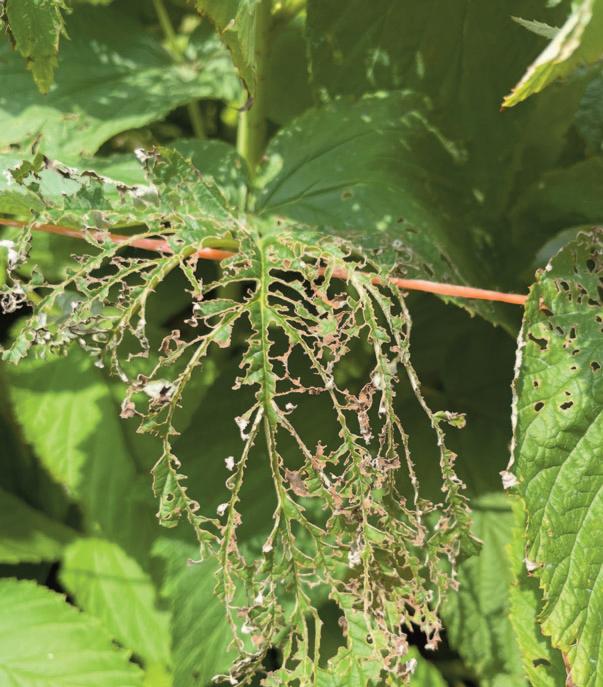

Further research on high tunnel covers was done in Minnesota where researchers (Burkness et al. 2022) looked at netting to exclude Japanese beetle in addition to plastic covers. A fine, nylon-mesh netting was used to cover the ends of the tunnels. Over the three years of the study, Japanese beetle populations were significantly lower in high tunnels with a plastic cover and mesh netting compared to plots with no
plastic or netting. Using a mesh cover on the ends of the tunnel was an effective method to exclude or repel Japanese beetle from the tunnel; using both plastic covers and mesh netting on the ends led to 100 per cent reduction of Japanese beetles in the tunnels in some cases. Using mesh netting in addition to plastic covers may also be a practical solution for spotted wing drosophila control, which can be successfully excluded with fine mesh netting.
More work is needed to understand the feasibility and economics of adopting these practices for pest control in tunnels on-farm, but these studies demonstrate the potential to use alternative pest control tools to improve Japanese beetle control and reduce reliance on pesticides.
Burkness, E. C., D. Nebbenga, A. G. Toninato, and W. D. Hutchinson. 2022. Exclusion and repulsion of Popillia japonica (Coleoptera: Scarabaeidae) using selected coverings on high tunnel structures for primocane red raspberry. Insects 13 (9): 771.
Cramer, M.E., K. Demchak, R. Marini, and T. Leskey. 2019. UVblocking high-tunnel plastics reduce Japanese beeltes (Popillia japonica) in red raspberry. HortScience Horts 54(5): 903-909.
Piñero, J. C. and A. P. Dudenhoeffer. 2018. Mass trapping designs for organic control of the Japanese beetle, Popillia japonica (Coleoptera: Scarabaeidae). Pest Manage Sci 74: 1687-1
Erica Pate is fruit crop specialist, Ontario Ministry of Agriculture, Food & Rural Affairs.


THE GROWER PAGE 14 –– SEPTEMBER 2023
Figure 2. Japanese beetle on raspberry leaves and fruit.
Figure 1. Skeletonized raspberry leaf from Japanese beetle feeding.
Honey Bee Health Initiative launched in Ontario

The governments of Canada and Ontario are investing more than $1.3 million through the Sustainable Canadian Agricultural Partnership (Sustainable CAP) to help improve the resiliency and competitiveness of beekeeper operations in Ontario.
“Honey bees and the producers who care for them play a vital role in the production and diversity of high-value agricultural crops in Ontario,” said the Hon. Lawrence MacAulay, federal Minister of Agriculture and Agri-Food. “Through this initiative, beekeepers will be able to access tools specific to their unique needs so they can continue building successful and
sustainable beekeeping operations.”
The new Honey Bee Health Initiative will help Ontario beekeepers maintain healthy honey bee colonies and will support them as they grow their number of colonies. Eligible activities also include equipment purchases or modifications of equipment that prevents the spread of disease and analysis work to support best management practices.
“Ontario beekeepers play an important role in honey production and maintaining healthy bee colonies which in turn, contributes to the pollination of Ontario crops,” said Lisa Thompson, Ontario Minister of Agriculture, Food and
Rural Affairs. “Our government is committed to working with our beekeepers to address sector challenges, explore new markets and ensure the sector remains competitive.”
This funding builds on previous programs, such as the 2021 back-to-back Honey Bee Health Management initiatives offered under the Canadian Agricultural Partnership (CAP). It also follows the recent commitment of $5 million through the AgriRecovery initiative, also through Sustainable CAP, to help Ontario beekeepers offset extraordinary colony losses due to extreme weather conditions in 2021-22.
This initiative will be delivered by the Ontario Soil and Crop
Improvement Association (OSCIA) and will directly contribute to the goals outlined in the Grow Ontario Strategy.
Source: Ontario Ministry of Agriculture, Food & Rural Affairs August 8, 2023 news release.
Canadian government tightens rules for imports of U.S. romaine lettuce
The Canadian government has released new temporary licensing rules for importers of U.S. romaine lettuce beginning September 28 and running through December 20, 2023.
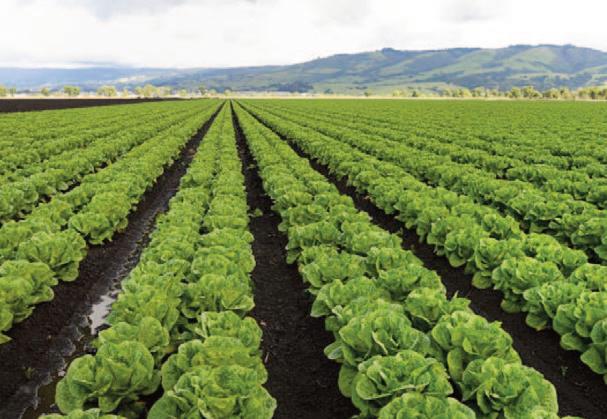
The Canadian Food Inspection Agency (CA FIA) summarized these new requirements:
“To decrease the risk associated with E. coli O157:H7 in romaine lettuce, the Canadian Food Inspection Agency (CFIA) is implementing temporary Safe Food for Canadians (SFC) license conditions for the importation of
romaine lettuce originating from the U.S. Between September 28 and December 20, 2023, importers of romaine lettuce and/or salad mixes containing romaine lettuce from the U.S. must:
• declare that the product does not originate from counties of Santa Cruz, Santa Clara, San Benito, and Monterey in the Salinas Valley, California, U.S., or
• submit an attestation form and Certificates of Analysis for each shipment to demonstrate that the romaine lettuce does not contain
detectable levels of E. coli O157:H7
Shippers sending romaine lettuce from other production regions to Canada during this time should expect to “provide a Proof of Origin indicating the state and county where the romaine lettuce was harvested.” Lack of proof of origin will require significant sampling and testing to ensure a lack of contamination before it will be allowed to be imported. Full details of this new rule are available on the website.
Canada Outdoor Farm Show features robotics and agtech
(with its RTK GPS guidance system that helps with weeding and hoeing chores).
• Other equipment available includes the AgroIntelli Robotti planting unit, Nexus GOAT with mechanical fingers for weed removal, and Korechi RoamIO weed scanning and autonomous soil sampling prototype. Additional features at Canada’s Outdoor Farm Show include demonstrations, pavilions and events to showcase what’s new and notable in the AgTech space, including:
the future of the agriculture industry.
• The OMAFRA Innovations Pavilion is a place to connect with entrepreneurs and startup companies that have booths displaying their new products for the agriculture and agri-food sector.
The annual Canada’s Outdoor Farm Show takes place Sept 12-14, 2023 at Discovery
Farm Woodstock, and is Eastern Canada’s largest outdoor farm show. To find out more about what’s happening at Canada’s Outdoor Farm Show visit outdoorfarmshow.com.
Source: Canada’s Outdoor Farm Show August 17, 2023 news release
With AgTech being a special focus at Eastern Canada’s largest outdoor farm show from September 12-14, 2023, farmers attending Canada’s Outdoor Farm Show can expect to see lots of new products and innovative technology over three days.
“Demand for food production continues to grow and there are increased opportunities for agricultural products and equipment that can improve farm productivity,” says Doug Wagner, director of Canada’s Outdoor Farm Show and Discovery Farm Woodstock. “AgTech is a focus of the show to help farmers stay competitive.”
For a look at the future of
agricultural automation, Canada’s Outdoor Farm Show features the Evolution of Farming Demonstration: Autonomous Equipment in Action, presented by Haggerty AgRobotics Company. Farmers can witness several robots in action in the field including:
• FarmDroid, a solar-powered robot that seeds and weeds – the demonstration crop was planted by the FarmDroid and at the demonstration, the robot weeds between the rows and around the plants.
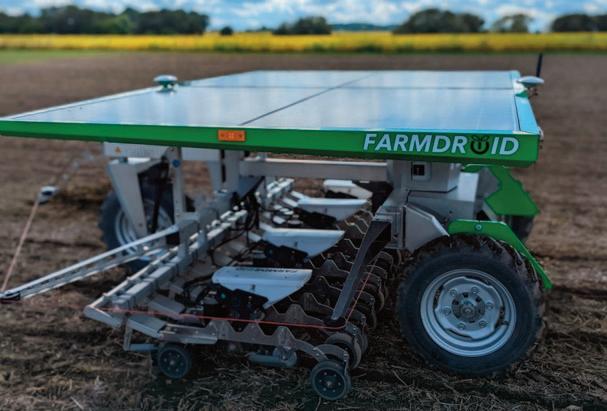
• Also weeding will be the Naïo Orio electric weeding robot (for vegetables and industrial crops) and the Naïo Oz inter-row robot
• Drone field demonstrations from Ag Business & Crop Inc., LandView Drones and Volatus Aerospace Corp. featuring a variety of drone models and equipment.
• A helicopter spraying demonstration from Great Lakes Helicopters showing aerial spraying (with water) to display a helicopter’s flexibility when applying products.
• AgTech Breakfast, sponsored by Bioenterprise, BMO, FCC and Ontario Ministry of Agriculture, Food and Rural Affairs (OMAFRA), on Wednesday, September 13 from 8:30 to 10:30 a.m. to connect farmers and innovators for discussions about technology and
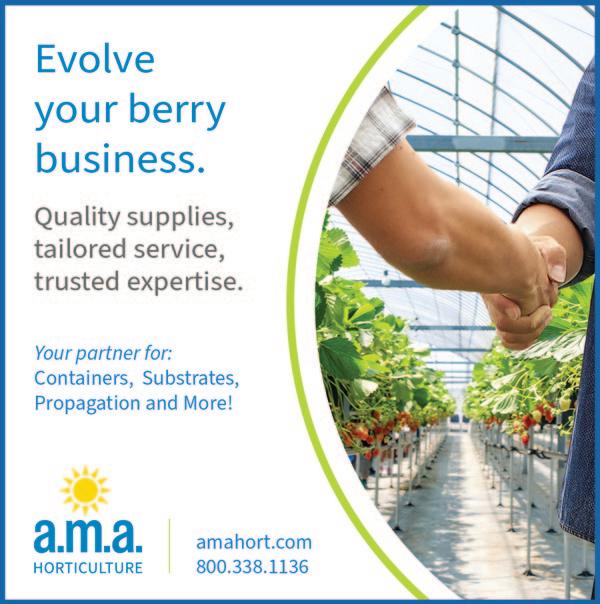
SEPTEMBER 2023–– PAGE 15 THE GROWER BITS & BITES
MARKETPLACE WORKS
•
• KNIP tree
• Call to enquire about the new variety Wild Pink. Call sooner and get what you want with better savings . . . contract work available.

BRIAN VAN BRENK 31760 Erin Line Fingal ON, N0L 1K0 5199026353 www.vanbrenk.ca brian@vanbrenk.ca
advertising@thegrower.org


866-898-8488 x 221
BLACK CURRANT PLANTS
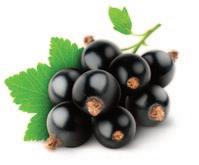
If you are thinking of commercially growing black currants, you need the best tasting, highest yielding varieties that were developed by McGinnis Berry Crops for North America’s growing regions.
Blackcomb, Tahsis, Stikine, Nicola & Whistler available ✓ disease resistant ✓ high yield ✓ great flavor

Order today for Fall 2024/Spring 2025 planting www.plaidshirtfarms.com • info@plaidshirtfarms.com phone: 226-321-2525

AVAILABLE EQUIPMENT

PRE-SEASON IS HERE – ADDITIONAL DISCOUNTS AVAILABLE. Order between 1st September and 30th September and get an additional discount through our Pre-season Program. Contact us for more details.
CLEARANCE SPRAYERS
Turbo-Mist 150-Gal 3PT HITCH $14,500 incl towers.
Turbo-Mist 400-Gallon $28,300 Turbo-Mist 500-Gal $33,900 incl towers.
Turbo-Mist 600-Gal $2,500.
Want to save 10% - 30% on chemicals through correct application? Retro fit a “Rate Controller” - call us.
MOWERS
Seppi Flail Mower. SMO 200 - $13,200 New Perfect Rotary Mower. RN 200 and LF-275 for $16,500 ea. Trade. Nice clean. Almost new. Several more models available from trades.
APPLE PLATFORMS/HARVESTERS
Hydraulic Working Platform $19,500 Narrow Orchard Harvester $114,900 CHINOOK WIND MACHINES






Contact for Pricing.
DEAL OF THE MONTH!
Turbo-Mist 500-Gal, Turbosteer 90 degree turning hitch, electric controls, cab pressure adjust, low drift towers. $41,600
OUR BUSINESS IS SPRAY BUSINESS: Parts and service available. Accepting trades. Book now for sprayer winterization and calibration, limited slots available.


Contact Wayne Mobile 289 213 6855 Email: sales@oves.ca


Locations: St Catharines www.oves.ca

PAGE 16 –– SEPTEMBER 2023
@growernews THE GROWER REFRIGERATION INNOVATION EFFICIENCY PERFORMANCE
NURSERY & ROOTSTOCK
Premium fruit and vegetable refrigerated cold storages DESIGN - SUPPLY - CONSTRUCT - MAINTAIN
519-983-6995 info@heye.ca
quality apple trees for 40 years.
GROW TRAYS Providing
Bench graft • 9 month bench
Formerly Don Arthur Orchard Equipment
ROWN ROWN
BIN & PALLET INC.
We are now taking orders for the 2023 season.
Please do not hesitate to contact us.

THE GROWER
CONTAINERS & PACKAGING
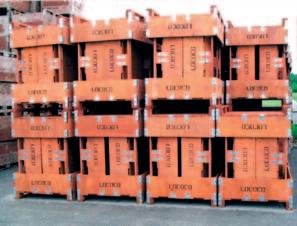

advertising@thegrower.org

866-898-8488 x 221
Office: 519-599-1224 Mike’s cell: 519-270-1145 mike@crownbin.ca
LOGISTICS
!"##"$%&#'&()*+,(-.(/&#"%"*,/

CANADA & U.S. CUSTOMS BROKERS INTERNATIONAL FREIGHT FORWARDERS
WITH 15 LOCATIONS 4 LOCATIONS OPEN 24/7 SHIPPING PARTNERS WORLDWIDE IN 150 COUNTRIES
HEAD OFFICE – TEL: (905) 673-2222 toronto@rutherfordglobal.com www.rutherfordglobal.com

@growernews
CROP PROTECTION
SEED & ROOTSTOCK
Strawberry Plug Plants Albion Various Sizes
Available September 2023 to June 2024
9036 Hwy 2, Great Village NS B0M1L0 Tel: 902-668-2005 d.cooper@balamore.com

REAL ESTATE
Just Listed
The Blueberry Patch
Operating for decades as a successful agricultural destination in Waupoos, this is an extremely rare opportunity to acquire stewardship of ‘The Blueberry Patch’! This destination in Prince Edward County is well-renowned by locals, businesses, and patrons afar. Set amongst other premier destinations that include delicious culinary, beaches, libations, and points of relaxation. With over 6 acres, the property is well equipped with a sprawling Quonset hut, refrigerator sea-can, and healthy crops to ensure the core infrastructure are all in-place. Explore the Possibilities!

KOPA insecticidal soap expanded to help manage spotted lanternfly nymphs on fruit trees and grapes in Canada
JOSH MOSIONDZ
The Pest Management Regulatory Agency (PMRA) recently announced the approval of a minor use label expansion registration for KOPA insecticidal soap for suppression of spotted lanternfly nymphs on fruit trees, and grapes in Canada. Note: Spotted lanternfly has not been detected in Canada at this time. This submission was reviewed by PMRA in the event a pest population is detected in an agricultural field.
KOPA insecticidal soap was already labeled for management of insects on a wide range of crops in Canada. These minor use proposals were the Ministère de l'Agriculture, des Pêcheries et de l'Alimentation du Québec as a result of minor use priorities established by growers and extension personnel.
The following is provided as an abbreviated, general outline only. Users should be making insect management decisions within a robust integrated insect management program and should consult the complete label before using Kopa insecticidal soap.
This product is toxic to aquatic organisms. Do not allow wastewater,
Fruit trees such as apples, apricots, cherries, nectarines, peaches, pears, plums, and prunes
Grapes
Suppression of Spotted Lanternfly nymphs
4-8 Mix 8 L of product with 400 L of water. Add sufficient water to the mixing tank to allow proper agitation by pump or paddles. Continue stirring while adding first the Kopa Insecticidal Soap then the remaining water. Hard water in excess of 300 ppm should be conditioned to reduce its hardness prior to mixing with Kopa Insecticidal Soap.
For field applications, apply the diluted solution at a rate of 700 to 1900 L/ha using ground spray equipment. For best results, commence treatment when infestation is first noticed. Thoroughly spray insect pests on plants with diluted product to wetting. Minimize run-off to reduce plant injury on sensitive plants. Kopa Insecticidal Soap is a contact spray and is effective in its liquid state. Pests need to be contacted with spray solution to be effective. Efforts should be made to thoroughly reach all plant parts including undersides of leaves. Repeat treatment every one to two weeks as needed. Apply to a maximum of three consecutive applications to ensure plant injury does not occur. Additional applications may be possible if previous experience with repeat applications of the product under the same conditions have not produced plant injury. May be used on edible crops up to and including day of harvest.
effluent or runoff containing this product to enter lakes, streams, ponds or other waters. Avoid direct application to ponds, streams and lakes. If this pest control product is to be used on a commodity that may be exported to the U.S. and you require information on acceptable residue
levels in the U.S., visit CropLife Canada's web site at www.croplife.ca
Follow all other precautions, restrictions, and directions for use on the Kopa insecticidal soap label carefully. For a copy of the new minor use label contact your local IPM Specialist, local
regional supply outlet, or visit the PMRA label site http://www.hc-sc.gc.ca/cpsspc/pest/registrant-titulaire/toolsoutils/label-etiq-eng.php
Joshua Mosiondz is provincial minor use coordinator, OMAFRA.

SEPTEMBER 2023–– PAGE 17
MARKETPLACE WORKS
Crop(s) Target Rate (L product /
Information PHI (days)
400 L) Application
0
65 COUNTY ROAD 38 $995 000
Chestnut Park® Real Estate Limited, Brokerage | 43 Main Street, Picton, Ontario, K0K 2T0 ROB PLOMER Broker D: 613.921.3325 O: 613.471.1708 plomer@mac.com KATE VADER Sales Representative D: 613.813.3604 O: 613.471.1708 k8vader@hotmail.com LORI SLIK Sales Representative D: 613.847.2349 O: 613.471.1708 lorislikfox@gmail.com
The Pest Management Centre: ‘growers are our reason for being’
I’ve been employed at the Pest Management Centre (PMC) since close to the beginning. That takes us back to June 2003 when Agriculture and Agri-Food Canada formally established this institution to deliver two programs, Minor Use Pesticides and Pesticide Risk Reduction. Through the years, I’ve seen plenty of changes. But essentially, the mission is still the same. Growers are our reason for being. We’re here to help growers access new minor uses of pesticides and to develop strategies and action plans to reduce the risk of pesticides to human health and the environment.
Right up front, it’s important to say we have a different role than the Pest Management Regulatory Agency (PMRA) which is under the auspices of Health Canada. The PMRA is the federal regulatory authority, responsible for providing safe access to pest management tools, while minimizing risks to human and environmental health. In other words, PMRA has the scientific expertise to evaluate and register new products. PMC provides the data, primarily pesticide residue and product performance, to support new minor uses of pesticides that PMRA evaluates for registration.
Our annual budget comes through Agriculture and AgriFood Canada. Our projects are determined through the Canadian Pest Management Priority Setting Workshop. It’s the culmination of months of work by the provincial minor use coordinators such as Caroline Bedard in British Columbia and Josh Mosiondz in Ontario who liaise directly with growers. They winnow through multiple requests for protecting crops as diverse as apples, grapes, ginseng to zucchini. The March 2023 face-to-face meeting in Gatineau, Québec identified 21 priorities that included four entomology projects, nine pathology projects and eight weed science and growth regulator projects for the 2024 growing season. An additional seven priorities will be chosen as joint projects in collaboration with the U.S. IR-4 Project, following its prioritization process in the fall.
What’s particularly valuable about this meeting is that provincial minor use coordinators are joined by growers, company registrants, and association representatives to share practical experiences. PMC and PMRA participants also benefit from the interaction with stakeholders.
Did I say 2024? Yes, it’s a long process. The first step is to determine the data requirements from PMRA. Pre-submissions are sent to PMRA to determine where the trials should take place.
Fresh mint, for example, requires three residue trials and one for mint oil in southern Alberta. That’s what we term “zone 7A” near Taber. Some crops are very complicated. So it should come as no surprise that it takes five years to make final submissions to the PMRA.
Five years? Yes, weather happens. Disease pressure may not be experienced in the trial area so that means waiting for
another crop cycle. Another year is required for the analytical phase.
Crop tolerance and efficacy trials can be difficult. There may be a huge need for a fungicide trial, but then drought happens, and the disease doesn’t show up. Also remember, that the registrants are owners of the crop protection products to be tested. That means permission is sought for use of the products and the company’s scientific experts must review the data. Companies agree to add the new use to the product label following evaluation by the PMRA.
To make best use of resources, one-quarter of this research will be conducted jointly with the U.S. IR-4 project. Celebrating 60 years of serving growers, the IR-4 project was established in 1963 by the U.S. Department of Agriculture and land-grant universities to ensure that specialty crop farmers have legal access to safe and effective crop protection products.
Over the years, the PMC has worked actively on pesticide risk reduction strategies. One of the most recent examples is working with Agriculture and Agri-Food Canada researchers as well as extension specialists in Québec and Ontario on molecular testing for weed resistance. We’ve held webinars and demonstration trials on this advanced technology that helps to reduce herbicide use.
The PMC’s Pesticide Risk Reduction team in concert with experts across the country develops and maintains crop profiles. The commodity-specific profiles feature pests of economic concern and detail key issues, gaps and management practices available to address these pests.
The information in crop profiles supports the development of reduced risk pest management approaches undertaken by Agriculture and Agri-Food
Pigweed species ID guide updated
This 41-page guide contains the most complete knowledge to date. It’s authored by Kristen Obeid, weed management specialist – horticulture and Dave Bilyea, University of Guelph weed technician.
Currently in Ontario, the pigweed family has confirmed resistance to six

of the eight herbicide groups where resistance occurs. This is the most of any weed species (Groups 2, 6, 7, 9, 14 and 27).



Genetic testing is available in Ontario. For sampling protocols, sample collection kits and the procedure for sample submission to
Spray applications using drones are the current focus, starting with projects for leeks and cherries, and expanding into additional projects comparing drones to traditional boom or airblast sprays in order to provide PMRA with a robust set of data to guide its evaluations.
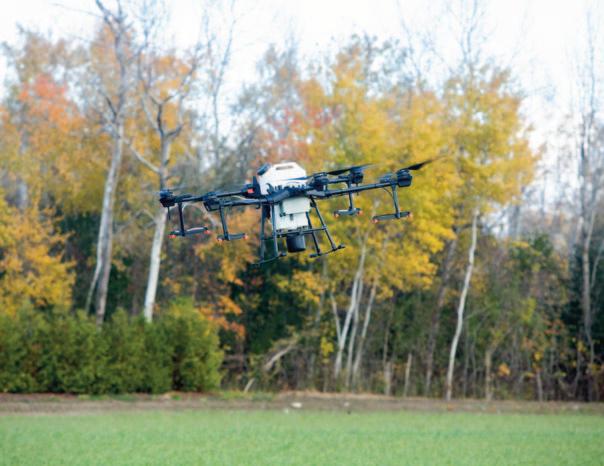
~ JENNIFER BALLANTINE
Canada. The crop profiles also support pesticide regulatory work done by PMRA. Besides being a resource to federal groups, the profiles are a source of current pest management information for provinces, growers and grower organizations and other industry stakeholders.
One of the interesting aspects of our role is the opportunity to work on new crops or using new technologies for pest management. Spray applications using drones are the current focus, starting with projects for leeks and cherries, and expanding into additional projects comparing
TurnKeyGenomics, contact Kristen.obeid@ontario.ca.


Link here: thegrower.org/news/pigweed-species-id-guide-updated
Source: Kristen Obeid, weed management specialist – horticulture, OMAFRA

N Natural crop protection
drones to traditional boom or airblast sprays in order to provide PMRA with a robust set of data to guide its evaluations.
After 20 years of supporting growers in their pest management tools and practices, we’ve certainly learned a lot, but our work is far from done. As pests and their dynamics continue to change and evolve so will we, and we’re looking to forward to improving and continuing our work for many years to come.
Jennifer Ballantine is submissions manager, Pest Management Centre, Ottawa, Ontario.

THE GROWER PAGE 18 –– SEPTEMBER 2023 CROP PROTECTION
Effective c control o of Botrytis s & Powdery Mildew Always read & follow label instructions TIMOREX GOLD is a registered trademark of Stockton Group
JENNIFER BALLANTINE
“
Danitol insecticide label expanded for spotted lanternfly on pome/stone fruits
JOSH MOSIONDZ
The Pest Management Regulatory Agency (PMRA) recently approved several minor use label expansions registration for Danitol insecticide for control of several insect pests in Canada including weevils and western raspberry fruitworm on caneberries (CG 13-07A); weevils on bushberries (13-07B); and spotted lanternfly on pome and stone fruits (CG 11-09, and CG12-09). Note: Spotted lanternfly has not been detected in Canada at this time. This submission was reviewed by PMRA in the event a pest population is detected in an agricultural field.
Danitol insecticide was already labeled for management of insects on a wide range of crops in Canada. These minor use proposals were submitted by the British Columbia Ministry of Agriculture and Food and the Ministère de l'Agriculture, des Pêcheries et de l'Alimentation du Québec as a result of minor use priorities established by growers and extension personnel.
The following is provided as an abbreviated, general outline
Caneberries (CG 13-07A) Control of Weevils (including Black Vine Weevil, Obscure Root Weevil, Rough Strawberry Weevil, Strawberry Root Weevil) Control of Western Raspberry Fruitworm
Bushberries (CG 13-07B) Control of Weevils (including Black Vine Weevil, Obscure Root Weevil, Rough Strawberry Weevil, Strawberry Root Weevil
Pome Fruit (CG 11-09) and
Control of Spotted Lanternfly
779 - 1169 Apply with ground equipment in adequate water for uniform coverage (minimum of 200 L/ha by ground). Begin applications when first pest activity is noticed. A second application may be used with a minimum application interval of 14 days. Weevils: Monitor for pest presence and apply when adults are actively feeding on foliage. Do not exceed 2 applications per year with a minimum application interval of 14 days.
779 - 1169 Apply with ground equipment in adequate water for uniform coverage (minimum of 200 L/ha by ground). Begin applications when first pest activity is noticed. A second application may be used with a minimum application interval of 14 days. Weevils: Monitor for pest presence and apply when adults are actively feeding on foliage. Do not exceed 2 applications per year with a minimum application interval of 14 days.
1169 - 1559 Make a foliar application as soon as the pest is detected. When possible, target smaller (first to third) instar nymphs for optimal efficacy. Do not exceed 1 application per year.
13 (hand harvest), 3 (mechanical harvest)
13 (hand harvest), 3 (mechanical harvest)
16 (hand harvest)
Stone Fruit (CG 12-09)
Control of Spotted Lanternfly
only. Users should be making insect management decisions within a robust integrated insect management program and
1169 - 1559 Make a foliar application as soon as the pest is detected. When possible, target smaller (first to third) instar nymphs for optimal efficacy. Do not exceed 1 application per year.
should consult the complete label before using Danitol insecticide. For a copy of the new minor use label contact your local IPM
specialists, local regional supply outlet, or visit the PMRA label site http://www.hc-sc.gc.ca/cpsspc/pest/registrant-titulaire/tools-
16 (hand harvest)
outils/label-etiq-eng.php

Josh Mosiondz is provincial minor use coordinator, OMAFRA.
Ethrel liquid plant growth regulator approved for field tomatoes
JOSH MOSIONDZ
The Pest Management Regulatory Agency (PMRA) recently approved a minor use label expansion registration amending Ethrel liquid plant growth regulator to differentiate PHI values between mechanical- and hand-harvesting methods used on field tomatoes in Canada. Ethrel liquid plant growth regulator was already registered for use on field tomatoes with the same use pattern in Canada. This minor use proposal was submitted by the Ontario Ministry of Agriculture, Food, and Rural Affairs as a result of minor use priorities established by growers and extension personnel.
The following is provided as an abbreviated, general outline only. Users should be making harvest decisions within a robust, integrated pest management program and should consult the complete

label before using Ethrel liquid plant growth regulator.
For a copy of the new minor use label contact your local vegetable crops
Mix 3.75 litres of ETHREL Plant Growth Regulator in 30 to 500 litres of water and broadcast spray uniformly over 1 hectare of foliage and fruit. When temperatures are expected to average less than 18˚C and vegetative growth is dense, mix 6.4 litres of ETHREL Plant Growth Regulator in 30 to 500 litres of water and broadcast spray uniformly over 1 hectare of foliage and fruit.
HARVEST FRUIT AT PROPER MATURITY, generally 14 to 21 days after treatment. Observe treated fruit frequently for condition of crop. Cool temperatures can slow colour development and extend the period between treatment and harvest. Some defoliation or yellowing of foliage following treatment will be observed.
specialist, local regional supply outlet, or visit the PMRA label site www.hc-sc.gc.ca /cps-spc/pest/registrant-titulaire/tools-outils/label-etiq-eng.php
3 Days for Mechanical Harvest
9 Days for HandHarvest
SEPTEMBER 2023–– PAGE 19 THE GROWER CROP PROTECTION
Crop(s) Target Rate (mL product / ha) Application Information PHI (days)
Crop(s) Target Rate (L product/ha) Application Information PHI (days) Field Tomatoes Promotion of earlier uniformity, and concentrated tomato ripening 3.75
Josh Mosiondz is provincial minor use coordinator, OMAFRA.
SEED & ROOTSTOCK NOVEMBER 2023 BOOK AD SPACE OCT 15, 2023 • AD COPY DUE OCT 20, 2023 advertising@thegrower.org featuring NEW NEW VARIETY VARIETY SHOWCASE SHOWCASE

SEPTEMBER 2023–– PAGE 20 THE GROWER












































































































